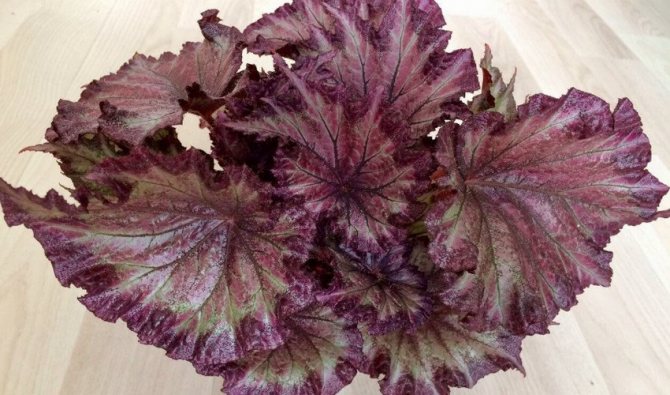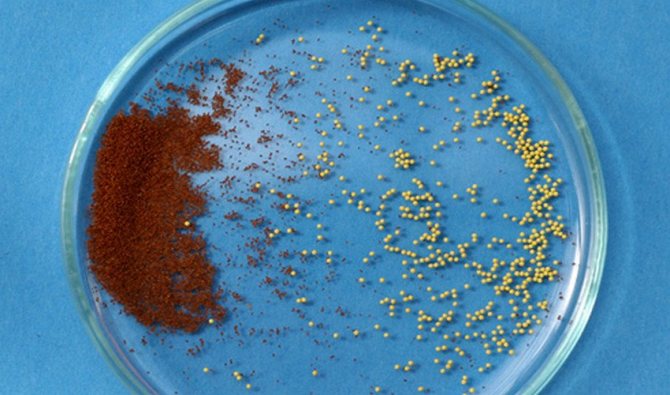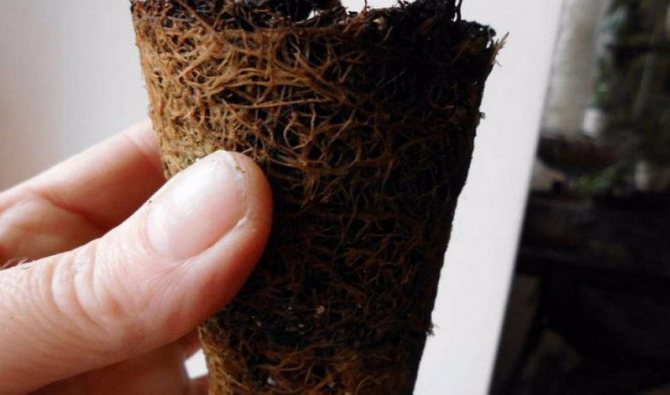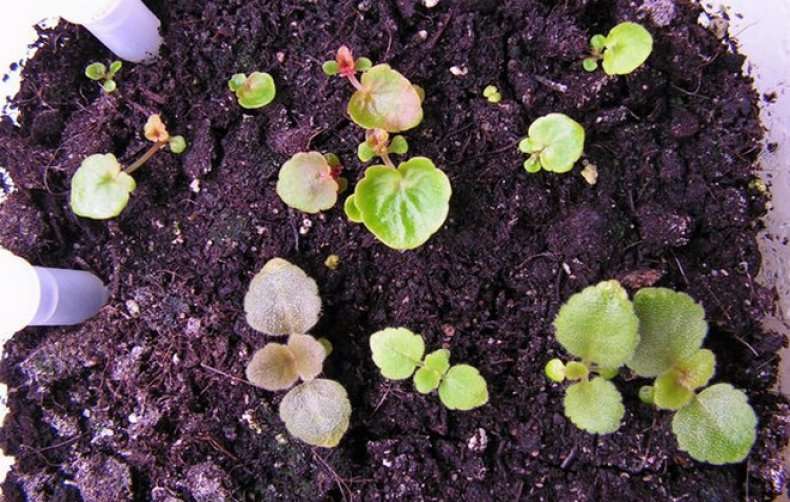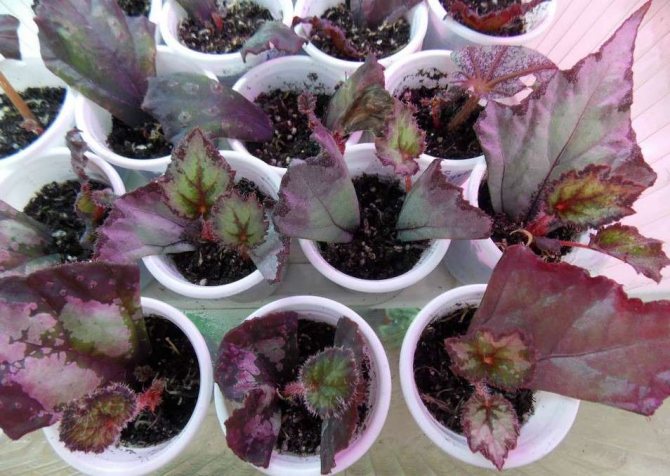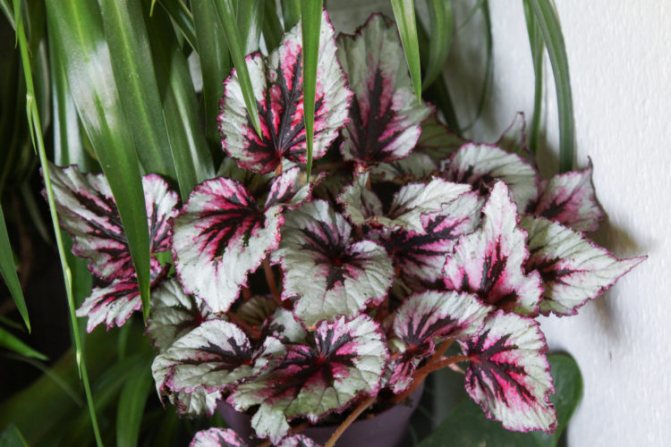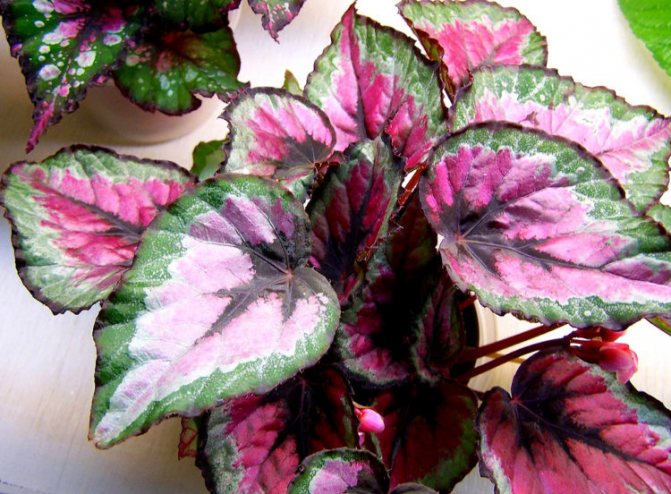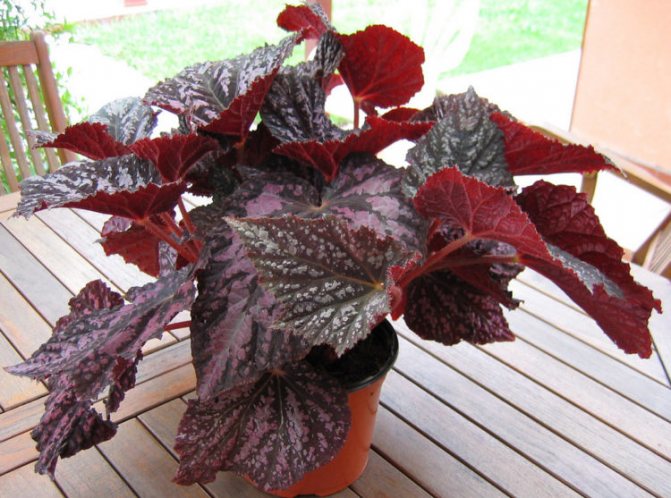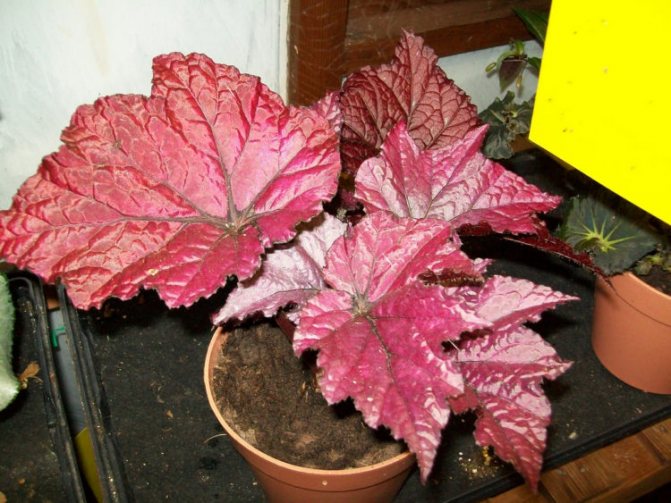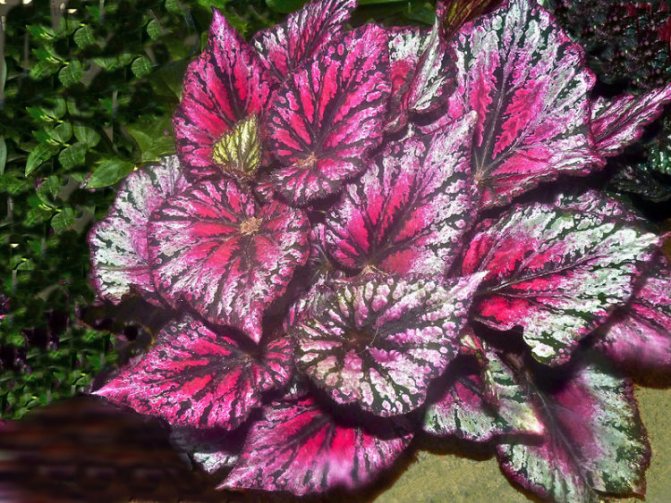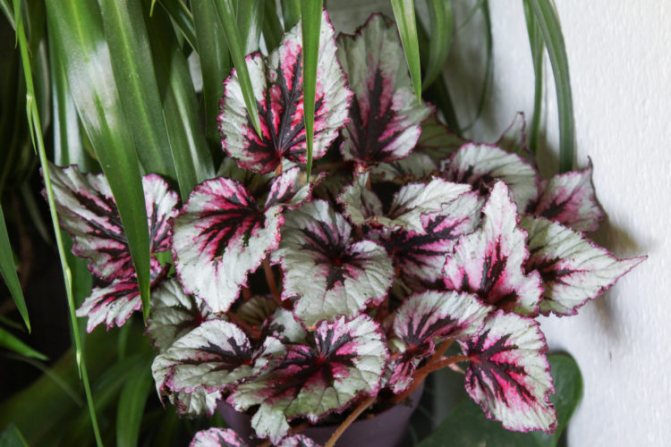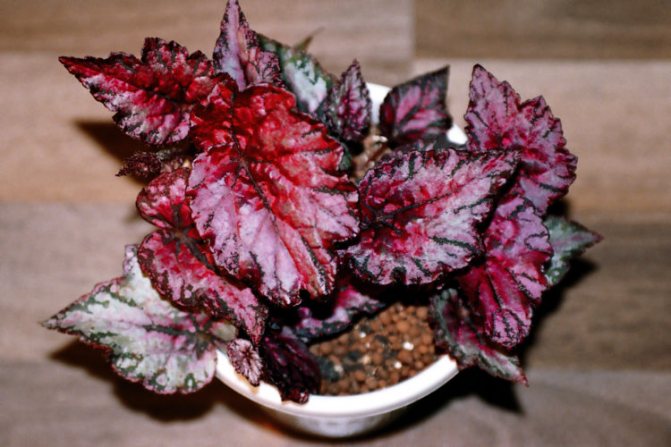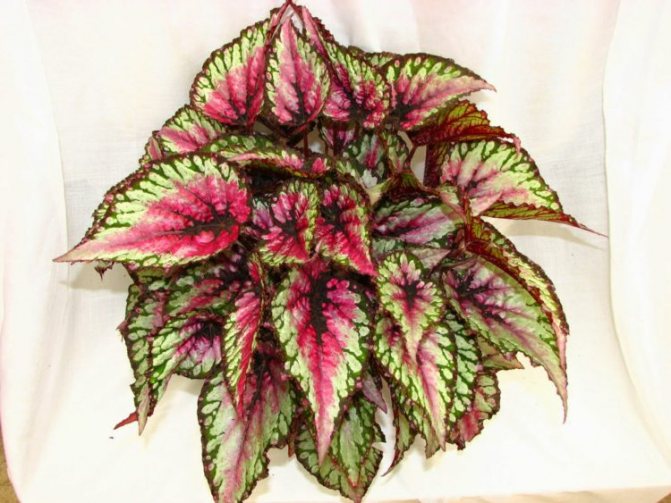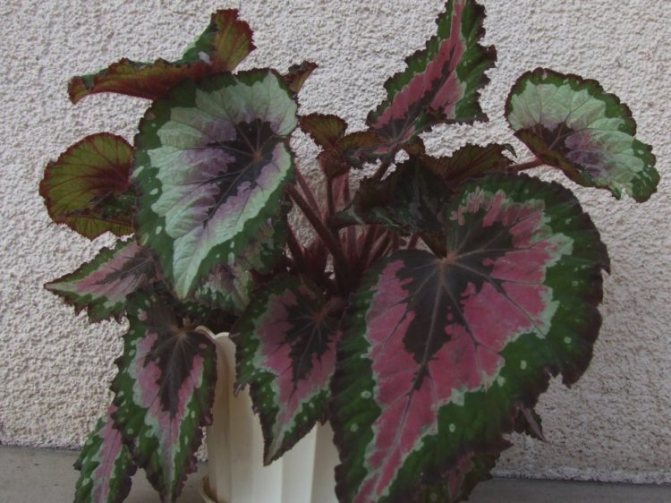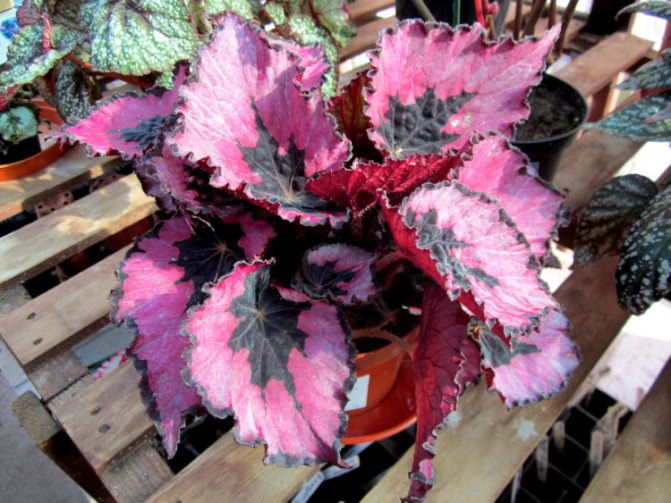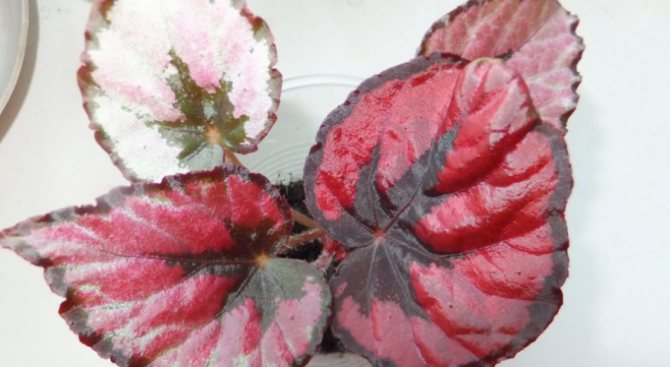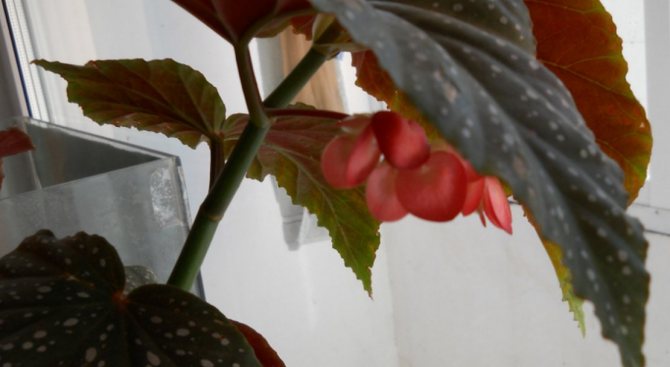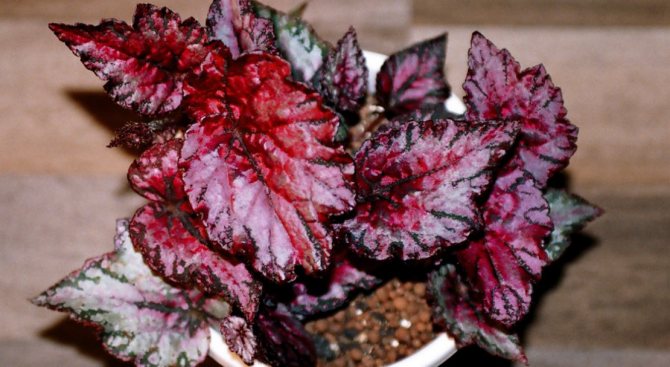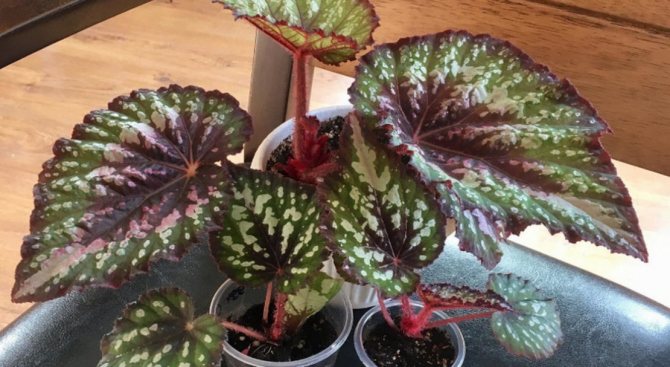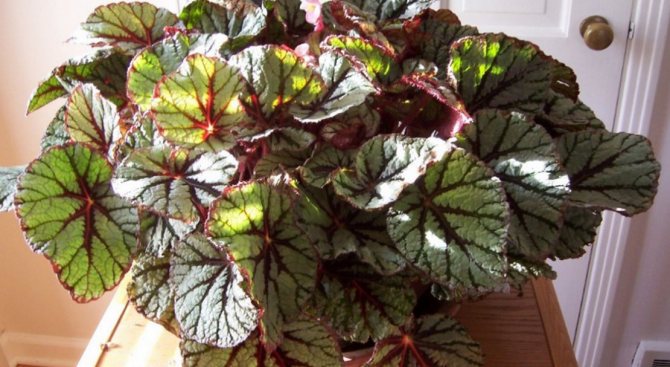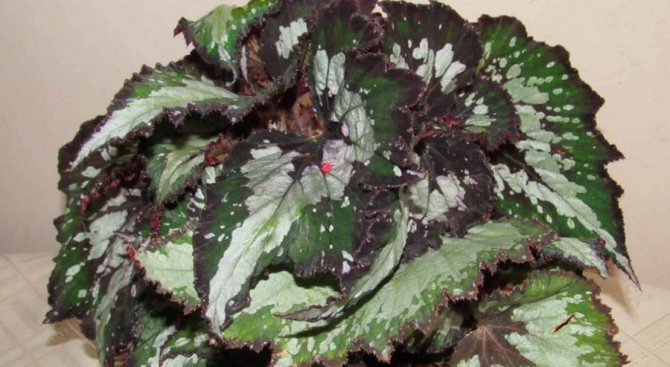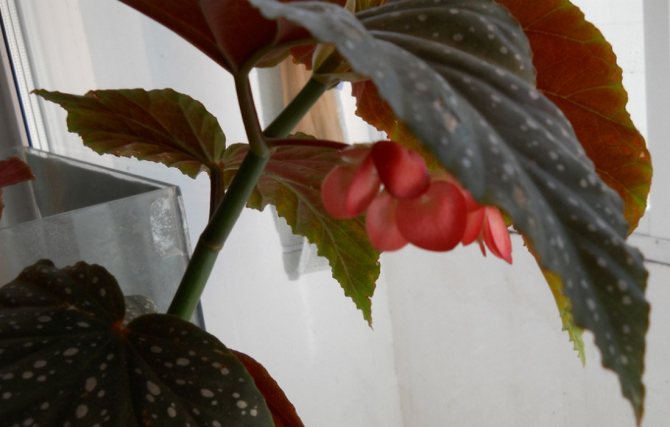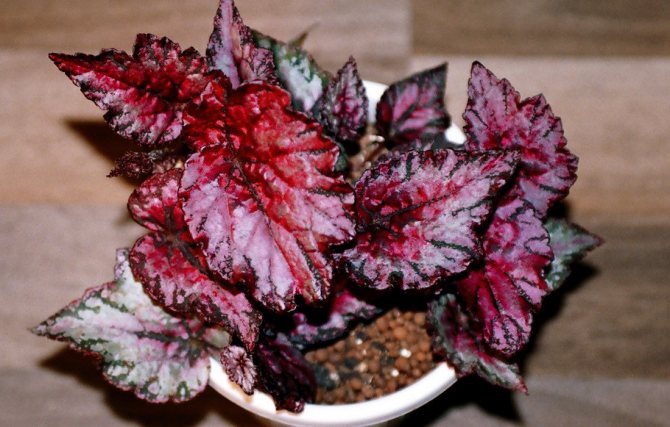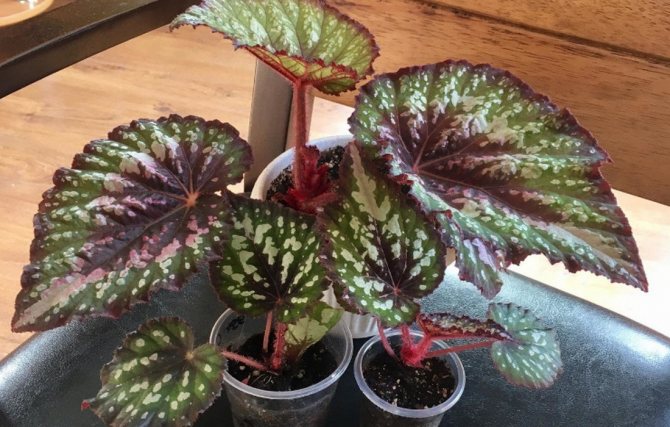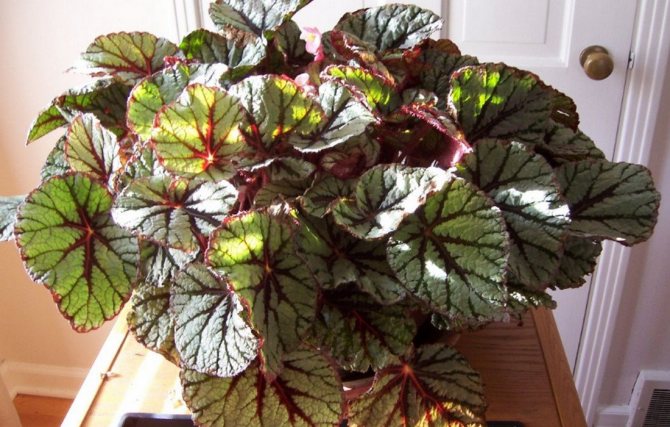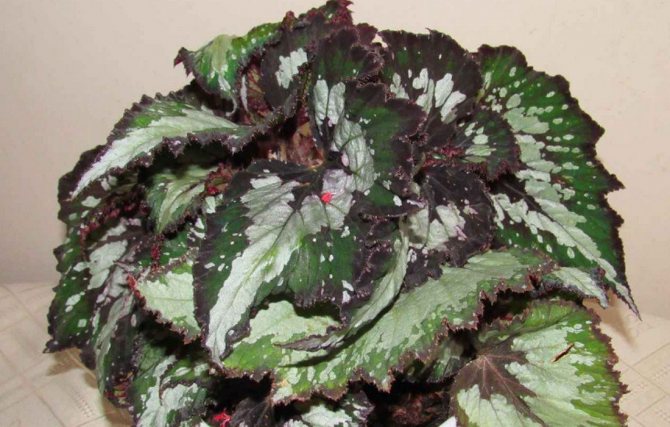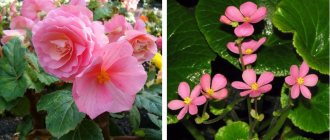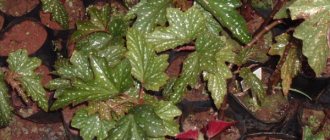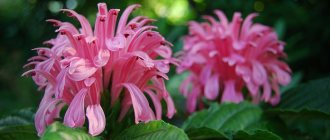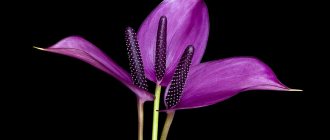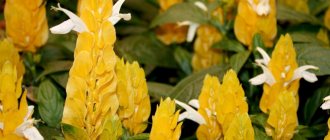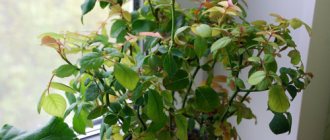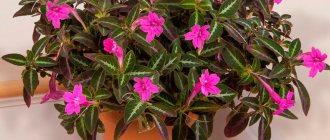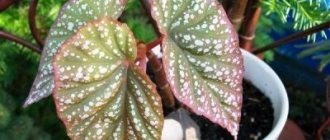The original ornamental deciduous plant Begonia Rex is not only beautiful, but also useful. Large pointed leaves have phytoncidal properties, purifying the air from harmful impurities.
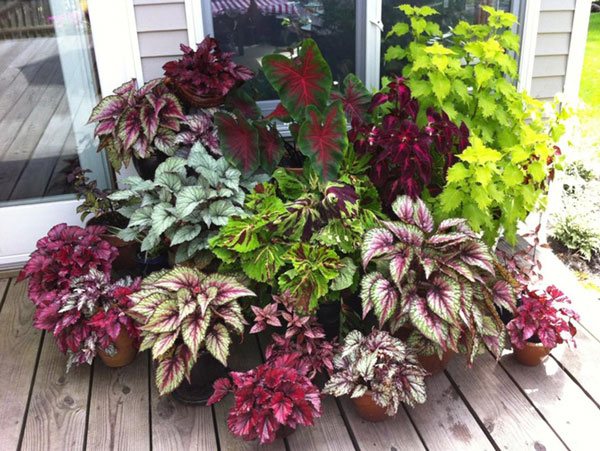
In nature, royal begonia grows in tropical forests. East India.
We use it exclusively in indoor floriculture.
For successful cultivation it is important to create optimal conditionsreminiscent of the warm, humid climate of their historical homeland.
Royal begonia has a thick creeping rhizome that rises above the soil surface.
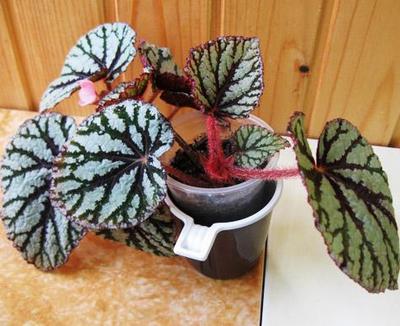

Leaves - broadly oval, asymmetric, with a cordate base and sharp edges.
Depending on the variety, the color varies from bronze-brown with silvery spots to cherry-red with a metallic sheen.
When the lower plates dry out, clear traces remain on the rhizome.
Small modest flowers are inferior to the decorative effect of the showy leaves and do not belong to the advantages of the plant.
2. Caring for royal begonia at home
2.1 Reproduction
Leaves and cuttings rooted in a mixture of moist peat and perlite, possibly with the use of growth hormones. Keep the seedlings in a warm, bright place with a temperature of 24 - 27 ° C. Leafy cuttings usually take 3 to 4 weeks to root, and they are able to give roots even in a simple glass of water. After planting, the cuttings should be covered with transparent plastic or glass to maintain uniform air humidity. Seeds sown in spring. The seeds are very small and they need light for germination, so do not sprinkle them with soil, at a temperature of 25 ° C germination will take 15 - 20 days. The vast majority of begonias are currently hybrids, so plants derived from seeds may not inherit all the beauty of the parent plant. By dividing the rhizome during transplantation. When grown in a cramped pot, royal begonias often form daughter rosettes - they are planted in separate cups.
2.2 when royal begonia blooms
Homemade royal begonia blooms in summer. The flowering is inconspicuous and so that the plant does not waste energy on it, the peduncles are often cut off.
2.3 Transplant
In the spring, when the rhizome outgrows the pot. Since the root system is shallow, use a shallow pot. You can split the rhizome during transplantation. After removing the plant from the pot, inspect the root system - the rotted roots should be cut off with a sharp sterile tool and sprinkled with crushed charcoal. Do not take too large containers for planting - excess soil will accumulate moisture and plant roots will rot.
2.4 how to care for royal begonia
For even light, turn the pot about ¼ turn every week. Leaves can fall off in low light conditions. Remove dried leaves regularly. In winter, these begonias sometimes shed their leaves and fall into a dormant state. If this happens, trim the wilted leaves, stop watering, and wrap the potted plant in a plastic bag. Keep cool - at about 16 ° C until new growth appears within 6 to 10 weeks. This kind of begonias should be taught to any changes in the content gradually.
2.5 Soil
Porous, slightly acidified soil based on peat, leaf humus, perlite and sphagnum moss, with the addition of a small amount of crushed charcoal. Grows well in ready-made mixtures for Saintpaulias.
2.6 Diseases and pests
Royal begonias are difficult to grow due to their high humidity requirements. Moisture on leaves and stems causes fungal diseases (such as powdery mildew) and rot. Dry, brittle leaves are the result of too dry air. When grown in the shade, begonias will stretch out and eventually die. Powdery mildew may occur if the leaves are directly sprayed. Stagnant water in the soil leads to root rot. Spider mites and whiteflies can appear from pests.
2.7 How to Water
Loves moist substrate, but does not tolerate stagnant water at the roots. The top layer of soil, about 2.5 cm, should dry out between waterings. Always use room temperature water when watering. When watering, try not to get drops on the leaves of the plant - lower watering is desirable. Excess moisture from the pallet, which appears after watering, should be immediately drained. In the winter months, the frequency of watering is reduced.
2.8 Containment Temperature
The optimum temperature is in the range of 18 - 24 ° C. It does not tolerate frost, but also does not like intense heat above 26 ° C - the plant may die during the day.
2.9 Lighting
Can tolerate slightly less bright lighting than most begonias, grows well under fluorescent lights. Feel best in bright, indirect sunlight. Backlighting in winter enhances the shade of the leaves. Direct sunlight can cause burns.
Growing problems
Royal begonias are highly susceptible to fungal diseases (eg root rot, gray mold), which can also be caused by over-watering and wetting the leaves. They can sometimes also be threatened by pests (such as spider mites), which must be disposed of with an appropriate insecticide. Plants are also susceptible to light. Too dry air dries up the ends of the leaves, and from too sunny a place, the plant will get burns and ugly spots on the leaves.
Types and varieties
At home, for the sake of beautiful foliage, they also grow:
- Red-leaved begonia or Fista (scientific name Begonia erythrophylla (feastii),
- Collar begonia, she is cuff begonia (lat.Begonia manicata),
- Begonia hogweed (Begonia heracleifolia),
- Spot begonia (Begonia maculata).
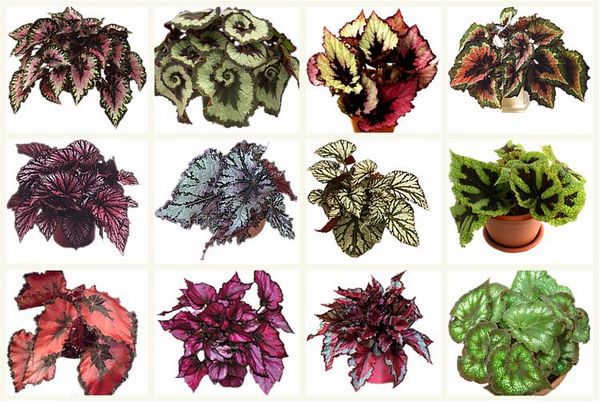

Yet the most popular of the decorative foliage group of begonias remains Begonia Rex. Thanks to the multifaceted work of breeders, several varieties have been created. Mini Merry Christmas, Escargot, Dollar Down, Grifon, Dark Mambo deserve more detailed consideration.
Mini merry christmas
The hybrid was bred in 1978 by the originator Woodriff. The average size of an overgrown plant is 30 cm.
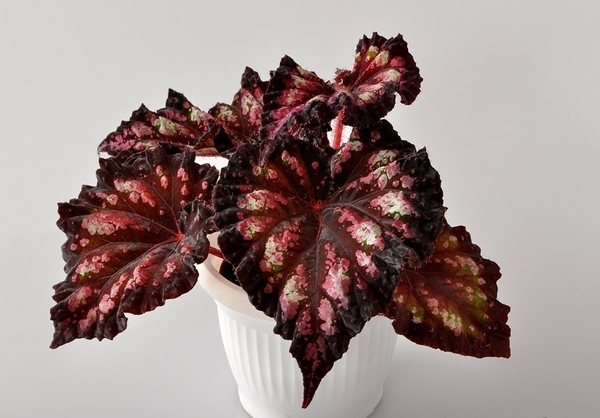

The upper surface of the leaf is velvety, the lower part of the plate is cut with large veins. The color changes from the center to the periphery. In the middle it is brown, then turns into red-crimson and white-green to the edge. The most variegated begonia variety.
Begonia Escargot
Two-colored silvery-green leaves, twisted in a spiral, resemble a snail (Escargot - frn.).
The surface is matte, covered with the smallest fibers. The bush grows up to 45 cm in diameter and 30 cm in height.
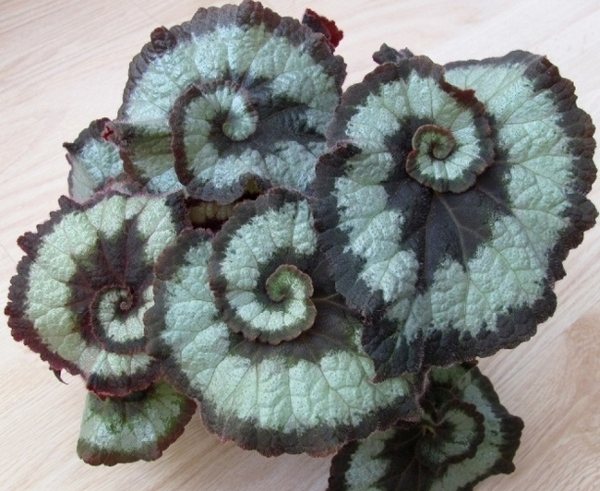

Dollar down
Begonia with cherry-red leaves with a dark border. The shape of the plates is fan-shaped, the size increases from middle to edge. The average height of this variety is 25-30 cm.
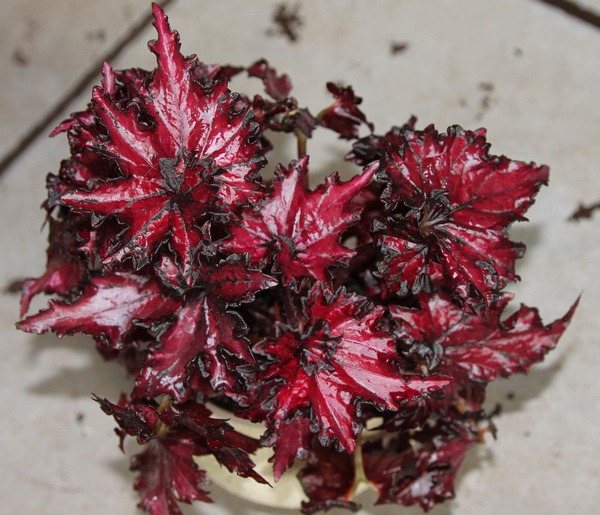

Royal begonia Grifon
Cut white-green leaves are arranged on long petioles. The total size of the plant is 40 cm. An extremely unpretentious flower to care for.
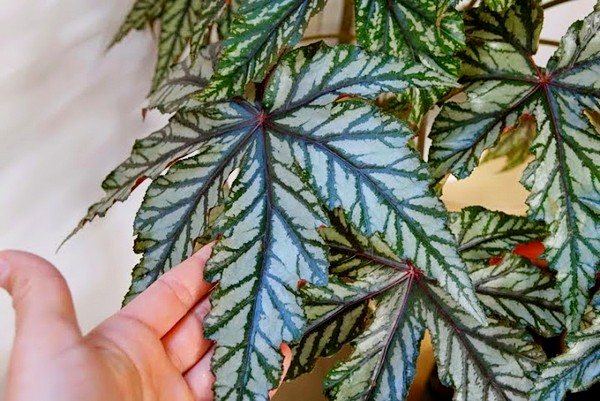

Begonia Dark Mambo
The deep dark green of the leaves looks completely black. The reverse side is brown-cherry. The growth of the plates is spiral.
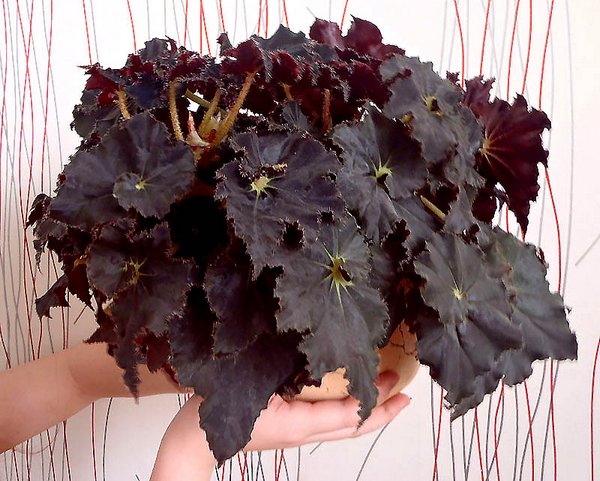

Content
- Royal begonia care
- How to transplant begonia
- Reproduction of begonias
- Problems of growing begonias
- Begonia pests
- Diseases of begonias
The parent species Begonia rex (in Latin - "king") was discovered in India in the state of Assam, introduced into cultivation in 1850, and was, of course, beautiful: dark green leaves with silvery gray spots. Immediately, its enhanced hybridization with other rhizome (rhizome) begonias began, therefore all modern begonias belonging to the Rex group are hybrids (in fact, this group of begonias bears the name of one of the parents), although the correct name is Begonia Rex-hybrid or Begonia Rex Cultorum. Many of the common rex begonias have been known to the world for many centuries: Begonia rex ‘Abel Carriere’ was obtained in 1878 and is still cultivated today. Subsequently, hundreds of varieties appeared. But at a certain point, hybrids began to be attributed to the Rex group, in whose genetics there was no original parental (wild) species begonia rex, which fundamentally distinguished this group. They just turned out to be extremely similar (Brad Thompson). It should also be noted that Rex begonias were used in crossing with the vertically-articulated rhizome begonias Upright Jointed Rhizomatous, and beautiful hybrids were obtained, which, like all Kings, have spectacular leaves.
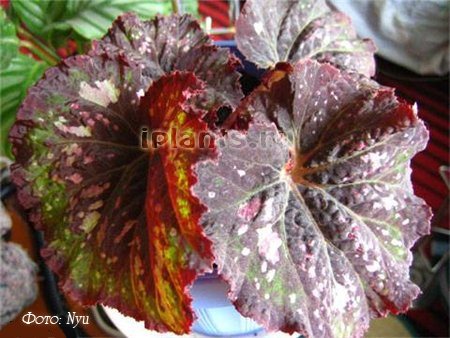

In general, according to the classification of all types of begonias, the Rex group belongs to rhizomatous (rhizome *) begonias, but due to some peculiarities (initially - the origin, later due to the peculiarities of care) they stand out separately, separately. Most of the plants are short, reaching a maximum of 1-1.5 m, with a lodging, creeping, eventually hanging stem, which is a rhizome. Traces of old, already dead leaves are clearly visible on it. Leaves on long stalks. The leaf shape can be: simple rounded, oblong, oblique-heart, cochlea, pinnate (slightly dissected or deeply dissected, stellate). The edges of the leaves are quite rare, often serrated or wavy. Leaves, petioles and "stem" are covered with thick hairs of various colors (whitish, yellowish, reddish, etc.). On the surface of the leaf, the hairs are very short, dense, which makes the leaves seem velvety. The hairs on the stems and petioles are sparse and longer.
The variety of leaf colors is striking: a different combination of colors, patterns, marbling of the pattern; some royal begonias have leaves with a metallic silvery sheen. The size of the bush and leaves can be from miniatures, when the leaf is about 5 cm in diameter, to large, with leaves about 20 cm in diameter.
Royal begonia: home care
For royal begonia to be a minimum of hassle, it is important to choose the right place. All varieties are supportive of good lighting, but cannot stand the scorching sun. They prefer a cozy, draft-free place. Grows successfully with sufficient moisture, suffers from drought and rot when over-watered.
Temperature
Optimal thermal conditions from spring to autumn +20 0 -25 0 ... At a higher temperature, the plant suffers, and with prolonged heat, it dies.
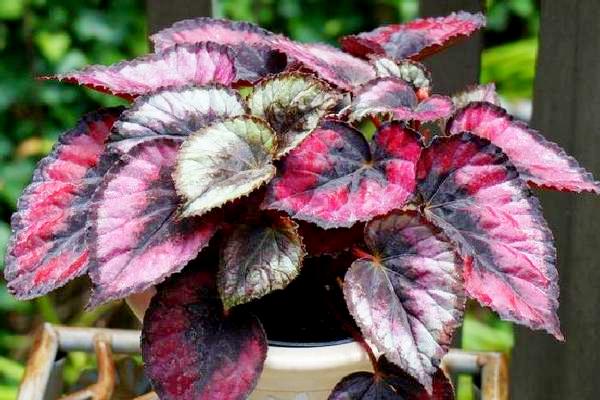

In winter, you should adhere to at least +15 0. The begonia does not tolerate the cold as well as the heat.
Lighting
Large, brightly colored leaves need enough light. In the shade, the petioles stretch upward, and the color of the plates becomes uncharacteristic for the variety, from which decorativeness is lost.
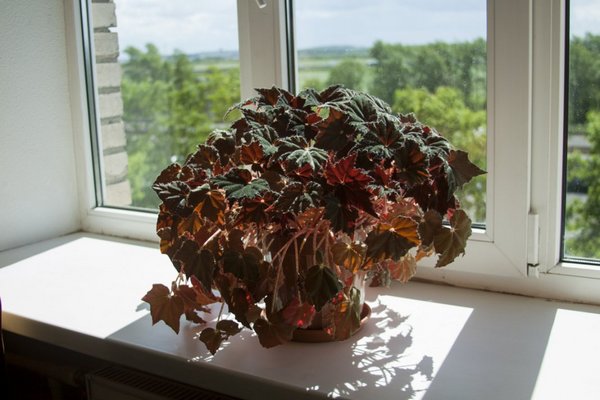

Subdued, scattered rays are optimal conditions for begonias.
If the plant is on the south side, it must be shaded from direct light. The northern direction, where there is never the sun, is not at all suitable. In the shade, the leaves turn pale and bulge upward.
Watering
The potting medium should be slightly damp. If the soil is completely dry, this is a signal for irrigation.
Water so that the water comes out in the pan, the remaining moisture is drained so that the water does not stagnate.
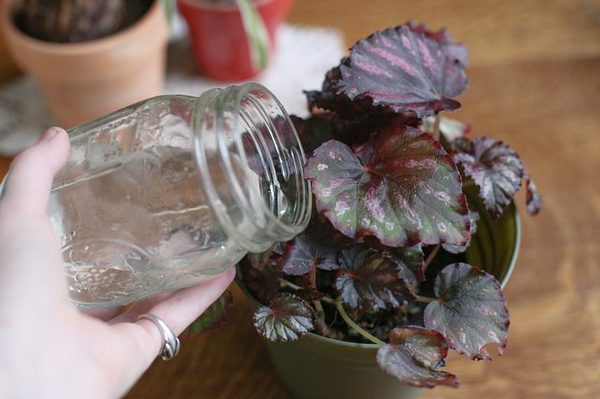

Soil and fertilizers
Can use ready-made soil substrate, for ornamental foliage plants or compose it yourself from the following components:
- Sod land - 1 part,
- Leaf compost - 1 part,
- Ground peat - ½ part,
- Coarse river sand - ½ part,
- Wood ash - 1/8 part.
Mix everything thoroughly and sift through a garden sieve. If it is not there, rub all the lumps by hand. Anything that is not shredded should be removed.
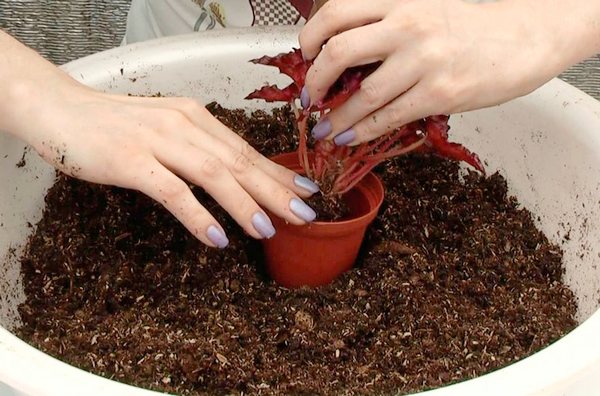

For feeding, fertilizers are used for indoor deciduous plants. In the spring, you need nitrogen-containing substances. In the middle of summer and autumn, phosphorus-potassium compounds are added.
Which pot to choose
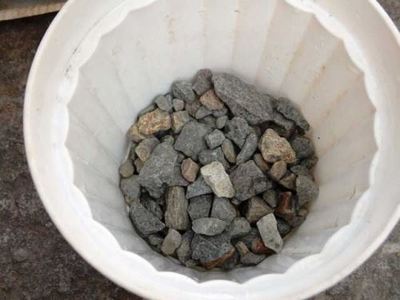

In begonias, the roots grow in width more than depth.
Therefore, the dishes are chosen not high, but with a diameter, not less than 20 cm.
Drainage material is placed on the bottom of the container, in a layer of 3 - 5 cm, to prevent stagnation of water.
Choose a spacious pallet from which excess moisture is easily removed.
Moisturizing royal begonia
Rex begonia needs to be watered often, especially in summer, dry land for it can end in failure. Immediately, as soon as the top layer of soil in the pot begins to dry, it means it is worth watering the plant. This decorative flower loves humid air, but does not need spraying. From this, spots may appear on the leaves. To humidify the air near the flower, just put a bucket of water next to it. It is important to know that the leaves of Rex begonia are fragile, it is very easy to break or harm them.
Reproduction
Leaf and cuttings
The most popular way is vegetative division.
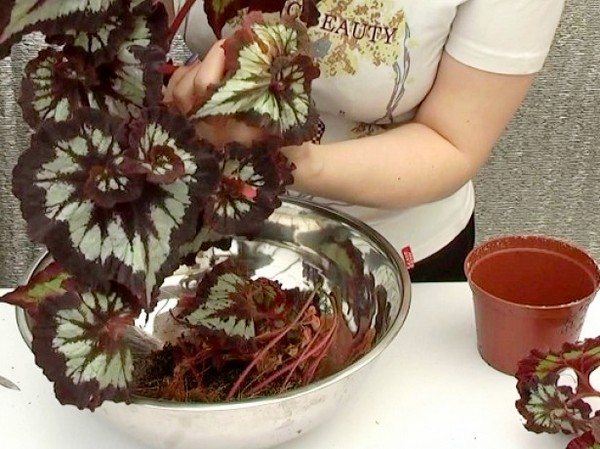

For him, leaf blades and cuttings are used.
- The prepared material is soaked in a rooting solution, for example, in "Kornevin", for 6 hours.
- Placed in a wet mixture of peat and vermiculite. You can not drop it in, but press it tightly.
- Cover with plastic wrap or a transparent lid.
- Moisten the substrate from time to time.
Problems of growing begonias
There are and will be problems with Rex begonias. This crop is as demanding as orchids. No wonder they are singled out as a separate group among decorative deciduous begonias.
First of all, the problem is the extreme susceptibility to bacterial rot and fungal diseases in conditions of high humidity. And they need this moisture most of all. But even if we place begonias on wide trays of water, and miniature ones in a terrarium, the problem remains - air movement. It is practically absent in the apartment, and the one that appears during ventilation creates a draft. Lack of ventilation is not a problem when the air is dry. But if it is very humid, mold fungi and bacteria multiply several times more intensively in stagnant air. In orchidariums, for example, to avoid such problems, a fan is arranged, but not one.
Therefore, the success of growing royal begonias in an apartment largely depends on the ability to maintain high air humidity and at the same time painlessly ventilate at any time of the year. Excessive moisture, by the way, is detrimental to plants at low temperatures.
The second problem that arises with Rex begonias is the inability to water with soft water. No matter how you defend and boil, a salt bloom still forms on the surface, stains on the leaves. What to do? First, go to a pet supply store and ask for a product that prepares your aquarium water for a fish stocking. These products soften water in minutes. But few people use them for indoor flowers, but in vain. Second, review the fertilizer you use on the begonias. Among them, there are many completely inappropriate, as I wrote about above: alkaline, with a large dose of nitrogen. Some do not even indicate the composition. Only fertilizers that acidify the soil are suitable for us, with microelements in a chelated form.At worst, it is safer to use fertilizers for conifers, azaleas or orchids than to take dubious for decorative deciduous or supposedly "begonias" poured from the same barrel as for ficuses or palms.
Diseases and pests
Such pathogens are dangerous for begonias:
- Gray rot
- Downy mildew,
- Bacterial rot.
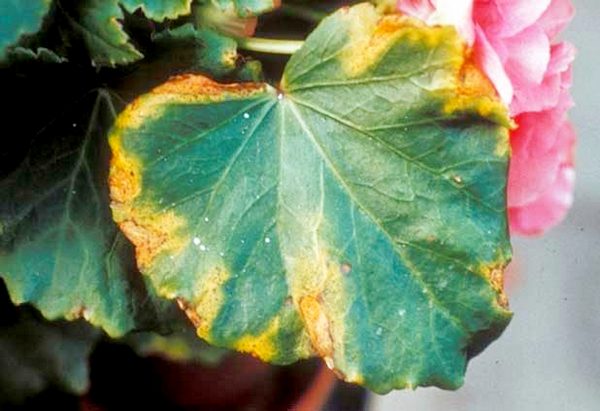

The source of infection is contaminated soil and high humidity. For the prevention and control of diseases, fungicides are used - Oxyhom, Skor, Abiga - Peak etc. If chemical agents are undesirable, it is better to use biological agents, for example Mikosan.
Among harmful insects, thrips are found on the leaves.
Care for most varieties of royal begonias is the same and uncomplicated. A spectacular plant will delight you with its unusual beauty for a long time if it is watered and fed on time.
Here are some of the secrets of begonia care that experienced florists share:
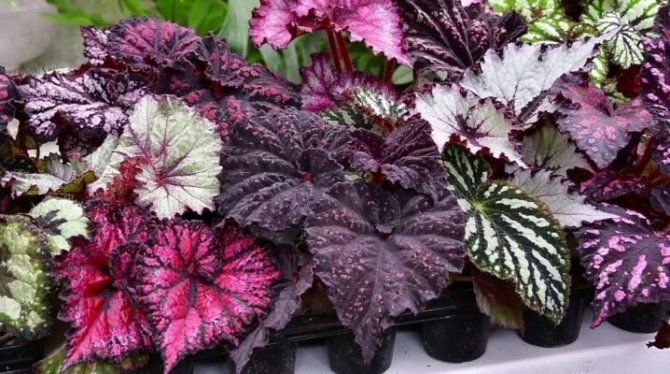

Royal begonia is one of the most beautiful and original flowers in the world. It is also often called "Rex" begonia. It has large leaves of a luxurious color, which are simply impossible not to pay attention to, in addition, this plant perfectly purifies the air due to its special properties. In this article, we will take a closer look at the description of this plant, with the popular varieties of royal begonia and their care. We will also take a closer look at the reproduction of this flower at home.
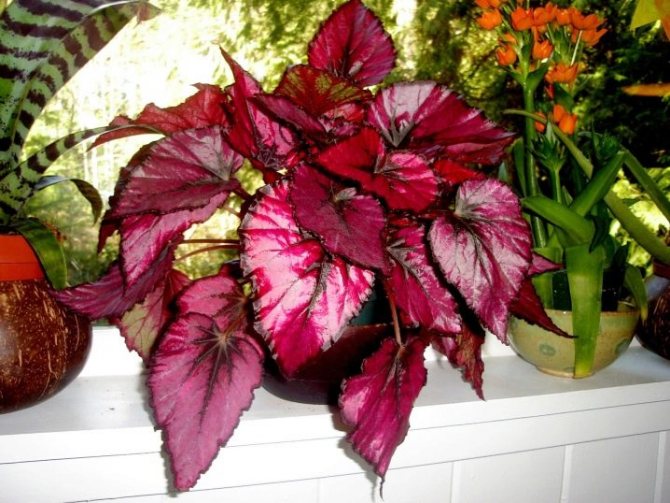

The necessary air humidity for the plant
In the room where begonia rex grows, the air humidity should be 55% all the time. Of the miniature varieties of begonia rex, there are harmful plants, they need 70% air humidity. The main disadvantage of this ornamental plant is that, despite the need for high humidity, they are susceptible to diseases, especially if there is increased dampness. This can be the ingress of water on the leaves, humid air, which has long stagnated, which entails the appearance of gray rot on the leaves. Ventilation must be good.
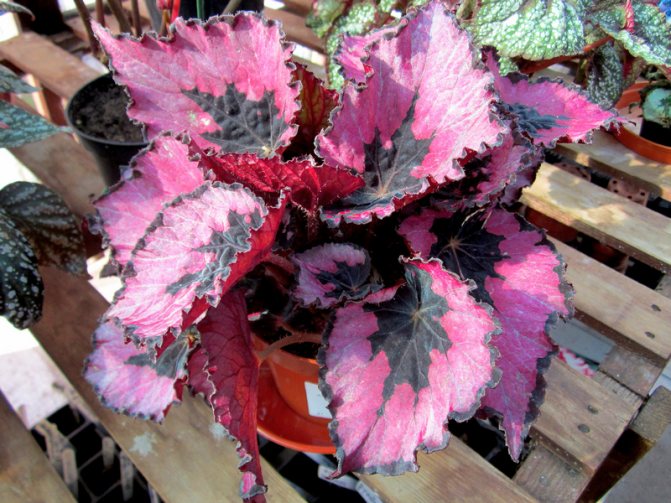

Description
Royal begonia belongs to the family of begonias. Almost all of its varieties have very original asymmetrical leaves with an unusual color. In nature, begonias are most often found in tropical forests and in the mountains. However, they survive well at home. Indoor royal begonia has a fairly large root system, which often rises above the soil. The leaves of this plant are wide, have a heart-shaped base and pointed edges. Depending on the variety, royal begonia has a different color of leaves - from gray-copper to cherry-brown with a special shine.
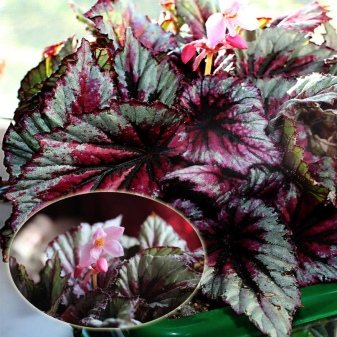

The flowering of the royal begonia is rather modest and even scarce in comparison with the leaves. It is the leaves that are the main advantage of begonia.
What temperature does the plant need
The plant belongs to the thermophilic species, the best temperature for it is 16-20 degrees. In summer, begonia rex does not like extreme heat and drafts. If you live in a private house, then the plant can be placed on the street, and in the apartment it can be taken out onto the balcony. Fresh air has a good effect on him. There are flower growers whose plants live on balconies, in which case it needs to be insulated for the winter so that the temperature of the bull is no more than +15. Royal begonias do not need to be placed close to cold glass. The main thing is that the root system receives as much heat as the plant needs, because if this does not happen, the leaves will begin to dry out, and after such a decorative flower will recover for a very long time.
Varieties
Today there are several varieties and types of Rex begonias. Almost all of them can be purchased at specialized stores. But first, let's consider the most popular types that are in demand among domestic gardeners.
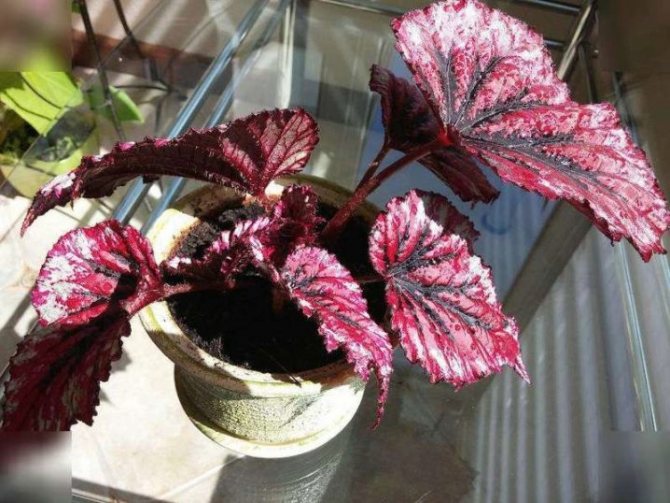

Fista red-leaved begonia
The variety is one of the most readily available begonias.Its distinctive features are large, rounded leaves of a red-green hue. As a rule, this species grows in a small, neat and compact bush, rather unpretentious to care for.
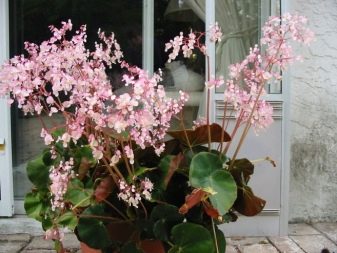

Cuff
One of the most picky subspecies is the Cuffed begonia. This plant has a creeping stem and light green pointed leaves with reddish veins on the back.
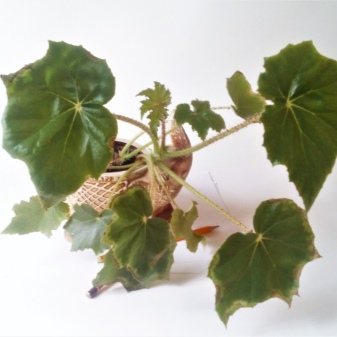

Hogweed
This kind of begonia has a very original stem of a pale pink color with a light edging, as well as large leaves that resemble the leaves of the hogweed, which mainly grows in Brazil.
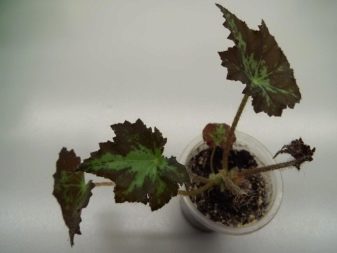

Thanks to the many years and fruitful work of breeders, several luxurious varieties of royal begonias have been created today.
Mini merry christmas
This black and burgundy hybrid begonia really looks like a cozy Christmas with its leaves. She belongs to variegated. Its leaves are velvety, have rather large veins, towards the edges, the color goes from rich burgundy with white dots to black.
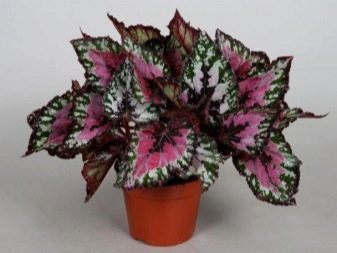

Escargot
Escargot begonia is also considered to be no less unique. Thanks to this plant, real tropics can be arranged right in your home greenhouse. The color of the leaves of this begonia is silvery green, and the pattern on them resembles a spiral or curl. Unlike the previous variety, this begonia has not velvety, but matte leaves covered with miniature villi. The average size of varietal large-leaved begonias, as a rule, is no more than 30 centimeters, which is very convenient for indoor cultivation.
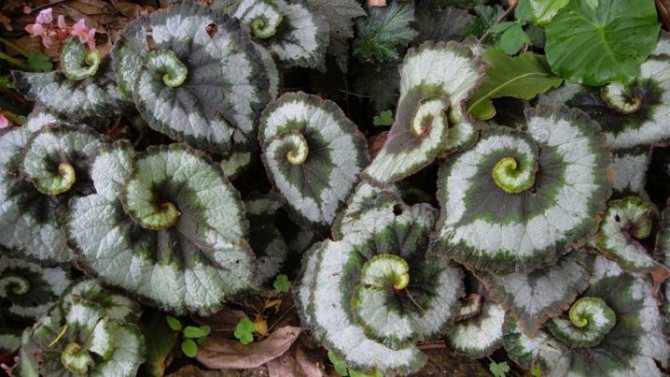

Dollar down
We also recommend paying attention to the luxurious royal begonia with pointed cherry-red Dollar Down leaves. The edging of the leaves of this variety is dark, which creates a very original effect when passing from one shade to another.
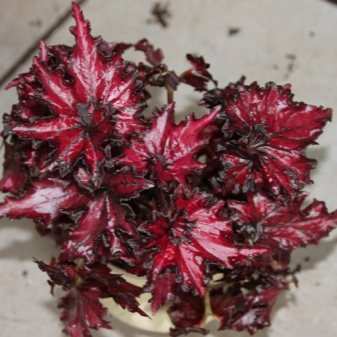

Griffon
The royal begonia Griffon can please with large saturated white-green leaves. It is this hybrid variety that grows the most, within 40 cm. Despite the fact that this is a selective species, it is extremely easy to care for it at home.
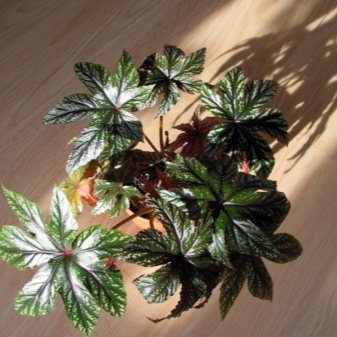

Dark mambo
Begonia with the original name Dark Mambo has a deep dark color. It got its name for its luxurious and sophisticated appearance, which immediately attracts special attention.
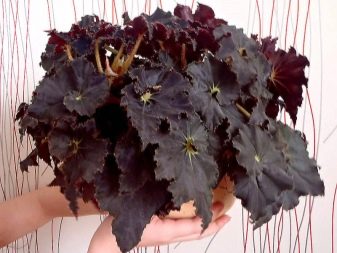

Indian summer
Large pink-black leaves can be found on the Indian Summer begonias. This flower actually looks like a king.
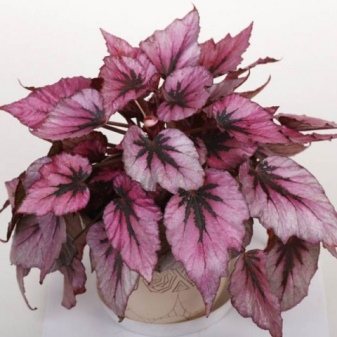

Helen lewis
Begonia Helen Lewis has velvety plum-black leaves interspersed with silver. All exotic lovers will like it.
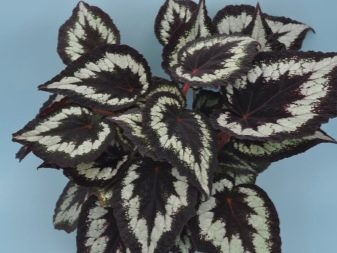

Fireworks
Fireworks is one of the most beautiful decorative begonias that are easy to care for. Its greenish-purple leaves with ornamented edging beckon to touch.
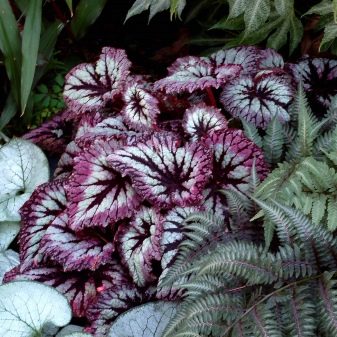

Beleaf Inca Flame
This varietal Beleaf Inca Flame begonia has rich, bright red leaves.
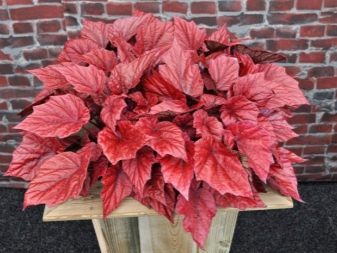

We also recommend paying attention to the Beleaf Inca Night, Morning Dew and Yukon Frost varieties.
Taking care of royal begonia at home is not so difficult. The main thing is to know some of the nuances of watering and feeding, as well as the selection of a suitable place to place the plant. Begonias are fairly light-loving plants, and it is because of this that they have such a juicy and bright color of leaves. Therefore, it is not recommended to place them in too dark areas of the dwelling. With a lack of light at any time of the year, the leaves of the plant can turn pale and even begin to dry. In this case, it is recommended to avoid direct sunlight. Begonia leaves are quite delicate, with direct exposure to UV rays, burns may remain on them. In general, the ideal place to place a houseplant is partial shade with enough incident light.
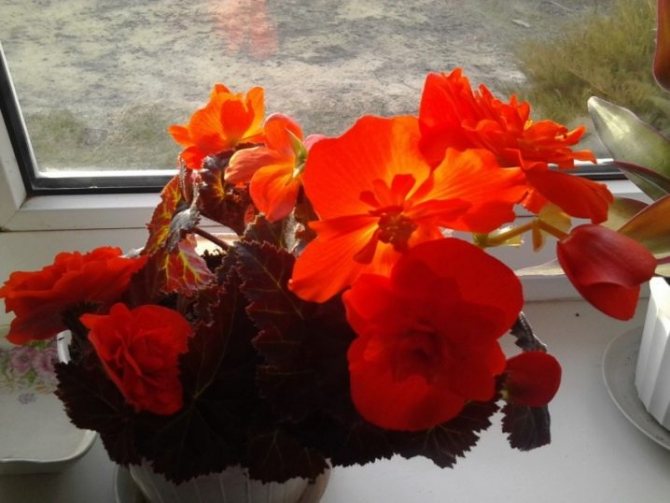

Royal begonia is tropical and therefore very thermophilic. The ideal temperature regime for its comfortable growth ranges from +15 to +25 degrees. Temperatures over 30 degrees and constant drafts are undesirable for her. In the summertime, pots of begonias can be taken out into the fresh air, but not in the open scorching sun. In winter, begonia can feel great on closed loggias, where the temperature fluctuates around + 16-17 degrees.
Correct location and illumination
Any begonia has bright green leaves, if there is not enough light for them, then the leaves fade and become pale. But, do not leave the plant on the sunny side, when the sun's rays directly hit the flower, this may cause burns on the leaves. In summer, the sun is as active as possible, so it is better to move the begonia into the shade. During the winter season, the plant will feel good on the windowsill. Rex begonia has a requirement, it is a bright diffused light. In the hot season, the plant needs to be shaded from 11 am to 4 pm. You can place begonias on the east or northwest side. Do not worry if the flower is on the north window, the begonia will grow well too, but only if it is not shaded by the light of trees or buildings. To understand that the plant does not have enough light, you can pay attention to the leaves, they will begin to lose their brightness, the pattern will become less noticeable. The illumination of the plant should be from all sides, otherwise the crown will form on one side. To prevent this from happening, the flower pot needs to be unwrapped a little every week.
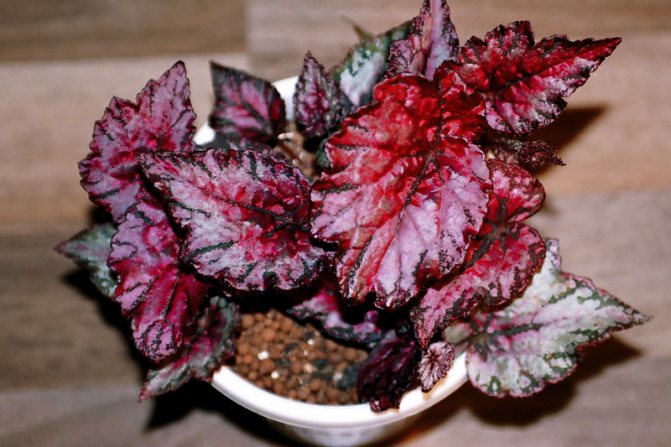

Transfer
Experts recommend replanting begonia once a year. Rejuvenation can be done every 3 years. It involves planting a new and fresh cuttings, which will later grow and replace the old plant. When transplanting a plant for the first time, you can use a container slightly larger than the previous one, so the plant will feel more comfortable, since it has a fairly developed root system. It is best to transplant the plant into a ready-made soil with an already selected substrate. When preparing it yourself, you should take leaf and sod land, as well as peat and sand. Humus can be added to the substrate, which allows the soil to "breathe" better. And so that the water in the pot does not stagnate, you should take care of the drainage, which fits to the very bottom of the container.
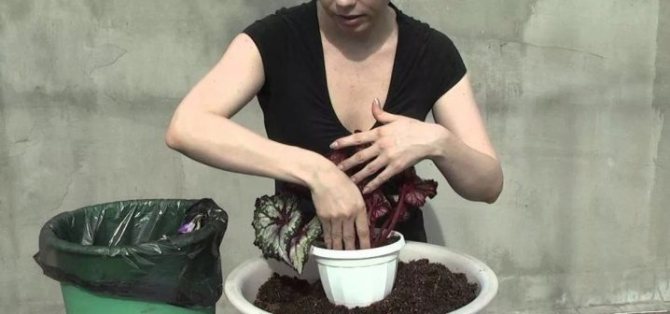

Begonia is best transplanted not so much into a deep container as into a wide one. This will help the roots grow better and the plant itself will look fresh and healthy. Several varietal begonias can also be planted in one large container. The result can be a very unusual floral arrangement.
How to transplant begonia
Royal begonias love slightly acidic soil, pH 5.0-6.0. But the main requirement for the structure of the soil is that it should be very loose, airy, rich in humus and dry out quickly, no longer than 2 days completely. Not suitable for planting Rex begonias are only garden land from the beds, and clean peat. More suitable is leafy soil in its pure form (collected under last year's leaf litter somewhere in a lime park). There may be several options for potting mixes:
- 2 parts sheet, 1 part peat, 1 part coarse river sand (or vermiculite).
- 2 parts of peat land, 1 part of coconut substrate (from briquettes), 1 part of coarse river sand (or vermiculite), 1 part of pine bark.
- 2 parts universal soil, 1 part vermiculite, 1 part sand, 1 part pine bark.
As you can imagine, sand and vermiculite are disintegrants. Pine bark also loosens and further acidifies the soil. And even with the addition of loosening components, it is necessary to ensure that the substrate in the pot does not cake, periodically loosen it with a thin, sharp stick. And when a salt crust forms on the soil surface, it is imperative to replace the top layer of the earth and soften the water for irrigation.
Royal begonias grow well in shallow and not too spacious pots, if the pot is large, the soil will dry out for a long time - this contributes to the development of pathogenic flora and root decay. But it is better to transplant begonias annually, in fresh soil, and in the same pot, if the root system has not grown too much.
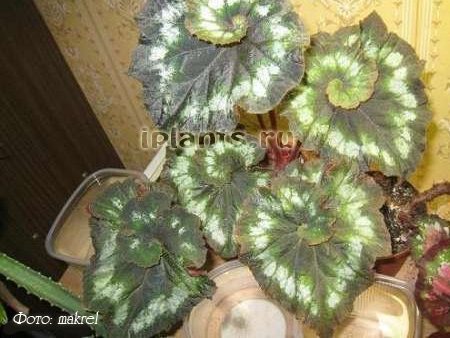

Some miniature Rex begonias can be grown in wide open aquariums, in fact, all conditions for them are similar to the requirements of orchids. Also air humidity, the same requirements for light and watering, even for fertilizers and pots. When growing Rex begonias on wide trays of water, and even more so in aquariums, you can and even need (!) Use pots with drainage holes on the bottom and sides of the pot. Basically, you can grow royal begonias in wicker (plastic) baskets, or you can make holes yourself. Perhaps I will surprise someone with such recommendations, this is my personal experience, but it helps to avoid root rot, bacterial spots and other diseases. In nature, Rex begonias grow in the surface layer of the earth, which is leaf litter, branches and twigs of trees - this is a very loose substance. Many begonias are semi-epiphytic and epiphytic.
I am against adding sphagnum moss to the soil for royal begonias, as it dries for a long time, absorbing too much moisture, but you can spread wet moss between the pots to increase the humidity in the air. And against growing Rex begonias in clay pots, the soil in them dries out quickly enough, but some of the roots stick to the unglazed sides of the pot, and the hole at the bottom is usually single and small. In plastic pots, you can always slightly squeeze the sides (walls), thereby loosening and airing the soil.
Reproduction
There are several ways to propagate royal begonia. Let's consider each of them in more detail.
- With the help of seeds. This method is not the most popular, since it is quite troublesome, and there are not as many plants sprout from seeds as we would like. Nevertheless, this method is inferior in price to many others, because seeds are the cheapest to purchase. Begonia seeds are too small, very much like dust. In addition, their germination is so low that only breeders and professional gardeners are engaged in seed reproduction, who are not averse to spending a lot of time on this process.
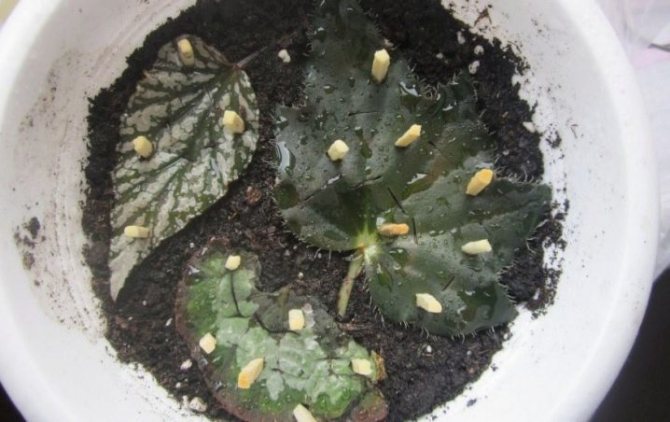

- Reproduction using rhizomes and tubers. As a rule, breeding varieties of royal begonias are rarely propagated in this way, although it is still used in some cases. It is quite difficult to deal with the division of the root system, since for better germination of the future flower it is very important to use that part of the root on which there is a growth bud, and there are not so many of them. To root future begonias, it is recommended to use special growth stimulants for this kind of indoor plants.
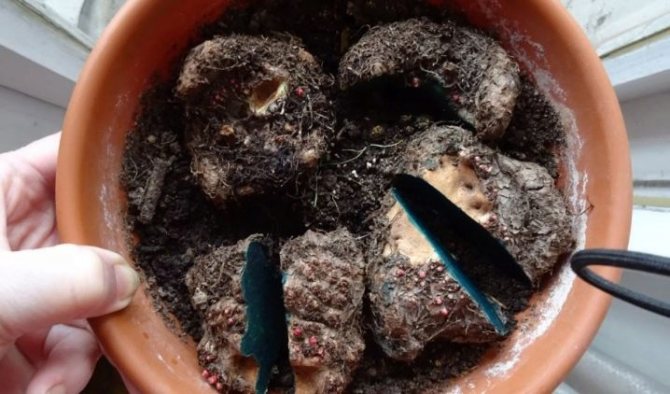

- The simplest and most common method of propagation is with a leaf or cuttings. Usually the cutting is left in a solution of a special rooting solution or simply in water for several days until the first roots appear, after which it is planted in a mixture of peat and soil, and then covered with glass or film. Every day, the substrate with the cuttings should be moistened, after which the grown sprout can already be planted in a separate soil. This should be done when the first small leaves appear on the young cuttings.
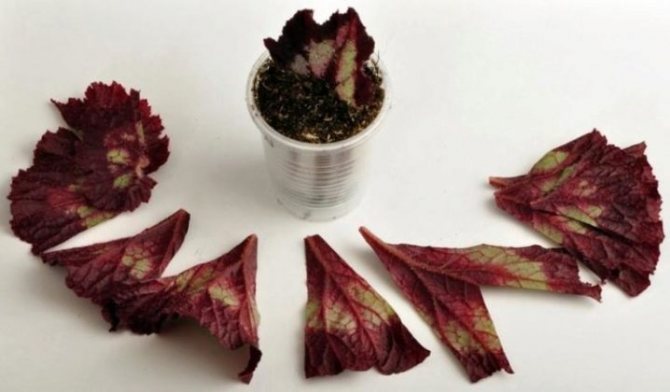

Correct reproduction of royal begonia
Such a plant lends itself to reproduction in a variety of ways. Whichever you like best, choose the one, it can be separation of roots, propagation by seeds or cuttings. For example, cuttings are cut, the roots are put in water, and the soil should be loose and moist, treatment with a root formation stimulator is allowed. They are covered with foil to retain moisture.Rex begonia is propagated through leaf particles, they are cut into small triangular pieces, but the top of each should end with a vein. Then the triangle is pressed to the ground and covered with a film. The film is lifted daily for airing. New shoots will appear in a month. When the shoots get stronger, they are transplanted for subsequent growth. You can propagate the plant through the root system, a small part of the root is separated during transplantation and sits in the substrate. You will not have to wait long, young shoots will appear quickly enough. Begonia rex, creates coziness in the room, gives the atmosphere of lightness and ease. Doctors recommend to grow such an ornamental plant to people who smoke, in their opinion, it prevents and prevents the occurrence of respiratory diseases.
How to protect begonias from diseases and pests
If you create the right conditions for a flower and, moreover, periodically make sure that pests do not appear, it will probably live its assigned period of 4-5 years. At the same time, the first signs of growth inhibition are observed after 3 years, so at this moment it is better to think about replacing the mother plant and propagating it by cuttings or rhizomes.
Begonia diseases
The most common developmental disorders associated with improper conditions of detention and infectious pathogens include the following.
| External sign | Cause | Solution to the problem |
| leaves dry at the edges, begin to curl | dry and hot air | rearrange to a cooler place, periodically humidify the air |
| leaves fall off or turn yellow and wither | too cold | rearrange to a warmer place |
| foliage wilted | polluted air or lack of moisture | take the pot to another room, water abundantly (if the ground is dry) |
| leaves grow small, flowers do not form or flowering is rare | lack of fertilizer | fertilize the soil with organic or mineral fertilizing |
| leaves fade, cobweb found | spider mite activity | use an insecticide or infusion of onions (more details below) |
| powdery coating with greenish and brown tints | gray mold fungus activity | spray with fungicide (benomyl) according to the instructions and put the pot in a dry, cooler place |
| white spots of a powdery consistency | powdery mildew activity | |
| the roots turn black and rot | black root rot fungus activity | stop watering, spray with fungicide, remove to a drier place |
| rot on the surface of leaves and flowers | waterlogging | reduce watering, prevent moisture from spraying on the begonia itself |
| leaves are deformed, yellow spots appear on the surface | activity of the cucumber mosaic virus | destroy the flower, disinfect the pot, replace the soil |
| the leaves have lost their color, on the roots there are influxes | nematode activity |
Pests and the fight against them
As for the pests of royal begonia, the most dangerous are:
- Spider mite - an insect of a rounded shape, bright red, less than 1 mm long. They look like numerous bright spots on the surface of the leaf and stems. Leaves cobwebs throughout the plant.
- Aphid has a different color (green, gray, brown), the shape of the body is rounded, 2-3 mm long. They look like numerous gray dots.
You need to deal with them immediately after detection. For this, special insecticideswhich can be purchased from a specialist store:
- thiophos;
- karbofos;
- actellik;
- neoron;
- fitoverm;
- fufanon.
They act clearly according to the instructions. You can also use and home remedy based on regular onions (with brown husks):
- Chop the onion very finely or pass it through a meat grinder.
- Take a full teaspoon (half a tablespoon) and infuse for 1 week in a liter of water.
- Strain and spray the foliage and stems until the insects are completely destroyed.
PREVENTION TIP
The foliage and especially the stems of the plant that are hidden under the bush must be carefully examined for the presence of these pests and other lesions. The sooner you start dealing with them, the higher your chances of success.
Description of the plant


The value of this species depends on how the royal begonia looks, or rather, its foliage. Small inconspicuous flowers do not have decorative effect, in contrast to bright and beautiful leaves. They are quite large and asymmetrical, with an uneven jagged edge.
The colors can be varied, but certainly very bright and attractive, which best suits the name of the variety. Colors can have inclusions of unusual shades: scarlet, lilac, crimson, purple and even silver. Veins often differ in tone from the main color.
These decorative features of the royal begonia are due to the specific needs of the plant.
- Due to the bright color and rough surface of the leaves, their temperature is increased to accelerate the evaporation of moisture. This helps to deliver more valuable nutrients to the root system.
- The asymmetrical shape of the leaf is caused by the need to receive sunlight. Due to the fact that all sheet plates are of different shapes, they do not overlap.
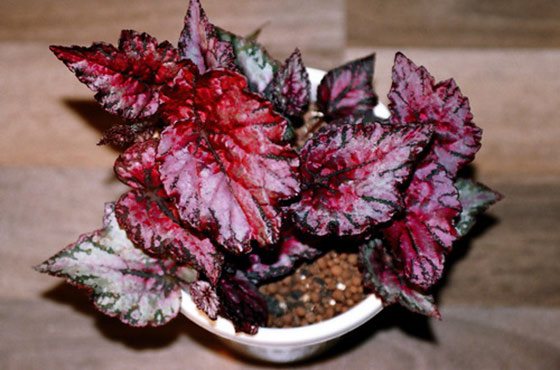

It is worth noting several aspects of how it is useful.
- Firstly, this variety has a positive effect on the respiratory system, so it is very good to keep it at home for smokers and patients with chronic bronchitis. It speeds up the treatment of throat and thyroid ailments.
- Secondly, begonia is believed to have exceptional energy. Perfect for people who host a lot of guests at home, and for creative people.
Diseases of begonias
Gray rot - appears on begonias at high air humidity, prolonged drying of the soil (within several days), especially under cool conditions. The parts of the rhizome, the lower parts of the leaf stalks, rot (soften, actually turn sour). Gradually, gray fluffy mycelium of the fungus becomes noticeable at the sites of decomposition.
Downy mildew is a fungal disease that usually appears as a result of a genetic predisposition in some varieties of begonias. Aggravated by high humidity, poor air ventilation. It begins with the appearance of yellowish or dirty gray spots, which are more noticeable in the lumen of the leaf, or on the back of the leaves. On the velvet leaves of begonias, they are noticeable when necrotic tissues become extensive. Spots are rounded, formed anywhere on the leaf blade.
Bacterial rot is practically no different from gray rot, only the mycelium of the fungus does not form. And outwardly - the same rotten wet spots on the pieces of rhizome, on the petioles and the leaves themselves. The reason is all the same waterlogging of the soil, its prolonged drying out, lack of ventilation, excessive fertilization.
Fungal and bacterial diseases can be fought with the help of fungicides (home, oxychom and other copper-containing preparations), as well as creating more suitable conditions for life (loose soil, proper watering, ventilation, sufficient illumination, optimal air humidity commensurate with the temperature).
* Rhizome is a creeping root-like stem of some plants, most often underground, but it can also be aboveground. Usually it grows horizontally, overground with a riza - lodging, or creeping along the surface of the earth (not high above the ground). New shoots and roots of the plant are formed from the rhizomes asexually. Underground rhizomes differ from roots in that they have buds, nodes, and scale-like leaves.
Begonia diseases
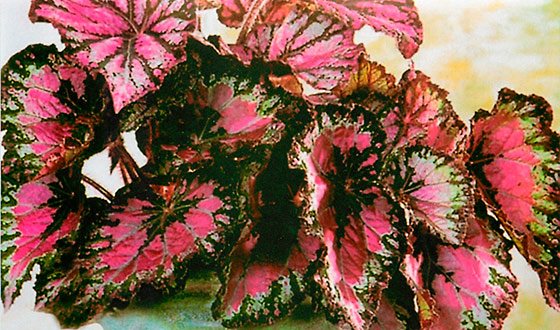

Most often, the poor health of the plant is associated with improper care of it. There are a number of the most common problems.
The most common question is why begonia does not bloom? This can be caused by improper temperature conditions, dry air, excessive fertilization, lack of light, or the presence of drafts.
If the leaves on the plant turn yellow and dry, then most likely the begonias lack moisture or nutrients. It is necessary to monitor compliance with watering norms, add top dressing, or even transplant the flower into fresh soil.
With an excess of moisture, fungal diseases can appear. If a damaged area is found, it must be removed immediately and the watering regime of the plant adjusted.
I would be grateful for reposting the article on your pages on the social network, let your friends have as many beautiful plants at home as possible.
Necessary conditions for keeping
Despite the fact that begonias are naturally considered unpretentious plants, it will take a lot of time to get a beautiful and bright flower. The first thing a plant will require is good lighting.
It needs intense and diffused light throughout the day. To do this, pots with begonia are placed on the windowsills in the east or west side of the house.
Also, this plant requires a special temperature regime for itself. The flower does not tolerate heat, therefore, in summer, the temperature regime for it should be about + 18 ... + 25 ° С, while in winter the temperature should not drop below + 16 ° С.
At the same time, the optimal humidity in the environment where the begonia is kept is also important. The indicator should be within 50%.
When choosing a pot for begonia, one should take into account the fact that moisture stagnation for the plant is unacceptable, therefore, the pot must have good drainage ability. The pot can be made of any material (ceramics, plastic, glass, etc.), while its dimensions play a dominant role.
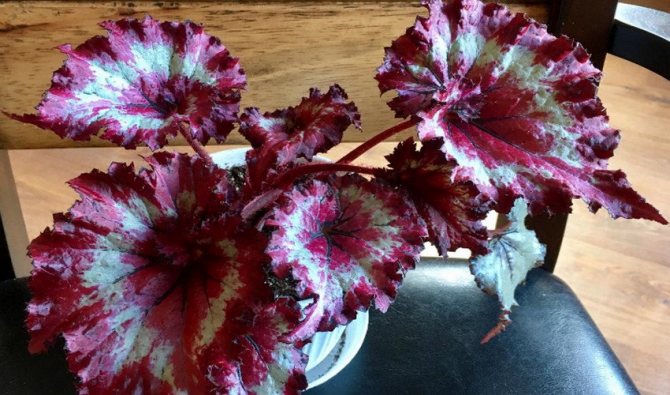

Young flowers are planted in vessels with a diameter of about 8-10 cm. Further, its size is chosen by the grower independently based on the size of the root system. In this case, those vessels in which the root system occupies about 50-60% of free space are considered optimal.
Soil for begonias can be used as a special store-bought or prepared with your own hands. Such mixtures are often made from leafy earth, peat and river sand (2: 1: 1).
An alternative to such a substrate can be a mixture of peat soil, coconut substrate, river sand and pine bark (2: 1: 1: 1) or a universal flower mixture, vermiculite, river sand, pine bark (2: 1: 1: 1).
Important! In order to get home begonia with high immunity, it is recommended to plant the flower in open soil. This will help sort out the most viable seedlings and harden the plants well.
Photo
Below you will see a photo of Rex begonia.
Do you like begonias? They are beautiful! Their bloom fascinates with its splendor and variety. Even when there are no flowers on them, the leaves of this beauty are gorgeous! We want to tell you about the most popular varieties of this wonderful plant. Read about these begonias: Metallic, Griffith, Royal, Griffin, Barshevik-leaved and Imperial.
Fertilization and feeding
In the warm season, the flower needs constant feeding with the use of a mineral complex fertilizer. Top dressing should be done 3 times a month, stimulating active growth.
Organic fertilizers are very useful for begonias. Manure fermented for two weeks, which is applied in liquid form when diluted with water, is well suited.
During the spring, fertilizer should consist of nitrogen, potassium and phosphorus in a ratio of 1: 1: 1, and by the beginning of cold weather, the content of potassium and nitrogen is reduced by 2 times.
Popular varieties
Florists have long been favorites among the varieties. These varieties are particularly decorative and perfectly adapted to life in a city apartment.
| Species name | Specific traits |
| Begonia Bauer | A tuber variety that must be removed from the soil for the winter. Low, up to 25 cm, plant with an erect stem and large asymmetric leaves. Flowers come in all shades from red to white. |
| Begonia nude | Long creeping trunks rooted at knots. The foliage is medium-sized, ovoid. Inflorescences are small racemose. Popular with winter garden owners. |
| Begonia Arthur Mallet | Hanging long stem with light green rounded leaves with contrasting burgundy or crimson spots at the petiole. A common hybrid variety. |
| Rich begonia | A perennial plant with a short, thick stem. Large egg-shaped leaves combine shades from light olive to silver. The flowers are small, creamy white. |
It is better to choose varieties in accordance with the interior design and individual aesthetic preferences. Photos will help you navigate in all the variety.
Possible problems
Despite its resistance to a variety of negative environmental factors, begonia has a fairly high susceptibility to a variety of diseases and pests. Although they are often not capable of causing the death of plants, however, with intensive development, they cause almost complete aesthetic unsuitability of plants.
Often this can serve as a solid sentence for the destruction of even the rarest and most exquisite specimen.
Diseases
Most often, royal begonia is affected by the following ailments:
- powdery mildew - a complex infectious disease caused by parasitic fungi Erysiphales
... The source of the disease is water, litter, garden tools, etc. infected with fungal hyphae. The infection manifests itself in the form of a white bloom on the leaves and stem. It causes tissue destruction and inhibition of flower growth. They fight the disease with the help of complex fungicides for indoor plants ("Topaz", etc.). They are used in two courses with a break of 14 days. The concentration of the medicinal solution is selected based on the manufacturer's recommendations; - gray rot - fungal infection caused by the development of fungus on the outer covers of begonia Botrytis cinerea.
The source of the disease is soil contaminated with sclerotia or conidia of the pathogen or its remains. The disease manifests itself in the form of numerous gray, black or brown rotten spots on the stem or leaves. They fight the disease by spraying begonia with 0.2% Fundazole solution or 1% Bordeaux liquid solution; - ring spot - viral infection of plants caused by a virus Tomato black ring.
The carrier of the pathogen is small nematodes belonging to the genus
Longidorus
... Most often, the disease manifests itself in the form of dark or light green spots on the foliage, smoothly turning into necrotic areas. Today, the disease cannot be treated, therefore, in order to avoid its spread, the affected plants are burned.
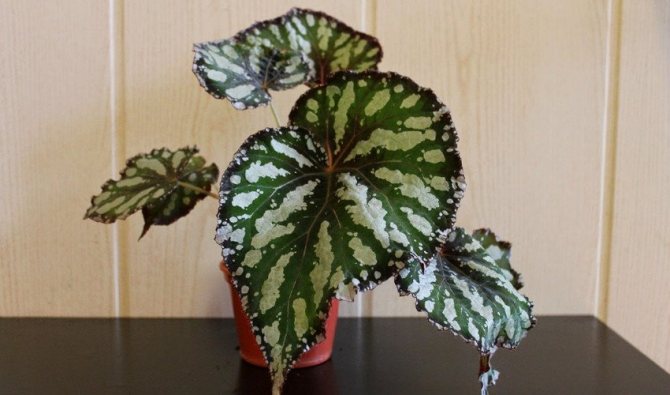

Pests
Among pests on begonias are actively developing:
- false shield soft - causes inhibition of flower growth, as well as deformation of the leaf blade. It is possible to identify the pest due to the characteristic sugary secretions and the appearance of sooty fungi on the leaves and stem. To eliminate the pest, every 14 days (until the traces of the parasite disappear), the plant is treated with a solution based on infusion of pyrethrum or garlic (10 g / l of water);
- greenhouse whitefly - small white insect, several millimeters in diameter. Parasitizing causes inhibition of begonia growth, as well as wilting of foliage and stem. They fight the pest by treating the flower with soapy water (4 g of laundry soap per 1 liter of water);
- gall nematode - a microscopic worm that parasitizes in the root zone. The parasite causes growths on the stem, which lead to wilting of begonias.They fight it by removing the affected areas of the plant, followed by treatment with a 0.05-0.2% solution of Heterophos;
- aphid - small black insects parasitizing on the back of foliage and stem. Aphids cause wilting and drying of individual parts of the flower. Eliminate it by treating plants for 5-7 days with onion infusion (15 g / l of water);
- spider mite - a small insect that causes wilting of the stem and leaves. The tick manifests itself as a characteristic cobweb, which braids the affected areas of the begonias. In order to overcome it, plants are treated with onion infusion (15 g / l of water) for 5-7 days.
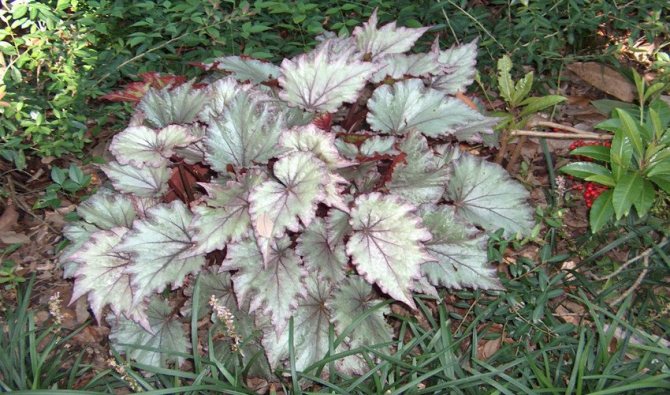

Royal begonia is a rather exotic, but at the same time unpretentious plant, so it can be safely grown in almost any climate, both in open soil conditions, and in indoor flowerpots.
Despite this, the plant requires a special microclimate from a person, including protection from pests, as well as common diseases. Otherwise, exquisite begonia turns into an average garden weed.
Leaf propagation
For this method of reproduction, a large, healthy begonia leaf is divided into parts with a sharp knife so that each of them has a central vein.
Then they are planted in a mixture of sand and peat, taken in equal parts. They are either laid out on the surface and lightly sprinkled with a substrate, or they are buried vertically with a lower cut by 1 cm.
The container with the leaves is covered with polyethylene or glass. Young specimens can be expected in 1-2 months.
Only then can you begin to ventilate the greenhouse, gradually accustoming the plants to room air.
Begonia pests
A beautiful arrangement, but these are usually short-lived - begonia will grow out of this vase too quickly. In addition, there are no drainage holes in it.
Thrips - these pests are hardly noticeable on variegated leaves, they are found when gray or brown spots appear on them, irregularly shaped, along the edges, in the center. Some of the leaves turn yellow. Black drops or crumbs, about 1 mm in size, are visible on the leaf surface. In this case, it is impossible to spray with an insecticide, you can only pour it with a systemic drug: a solution of an actara or a confidor. As a last resort, use an insecticide spray. Thrips is a flying pest, so look for signs of infestation on other plants in your home as well.
Mealybugs: often appear on begonias, and can lead to the complete death of the plant. They hide in the husk from stipules in the lower part of the rhizome, intensively sucking out the juice. This becomes noticeable when the leaves fly around en masse, and the worms form whole colonies. Signs - white shaggy, as if cotton, lumps at the base of leaf stalks. Examine the rhizome carefully if the plant suddenly begins to dry out. You need to fight the worms using the same insecticides - pouring with a solution of actara (1 g per 1-1.5 liters of water). On the leaves themselves, the worms usually do not appear (in extreme cases, they hide at the very base of the leaf plate from the bottom side), so the rhizome itself can be treated with an insecticide in a spray.
Rejuvenation and reproduction methods
The tropical beauty Rex is not a long-lived perennial. After 2-3 years, the bush loses its compactness and falls apart. To preserve the decorative properties, the plant is regularly updated, or a new one is grown to replace the old one.
Royal begonia prefers vegetative propagation - by leaf cuttings or by dividing the rhizome.
Rooting a fragment of a leaf
A large leaf plate is divided into segments so that each has a thick vein that will give a baby. The soil for planting is taken loose, moistened in advance, poured into a transparent cup. A leaf is planted here, placed in a greenhouse. For this purpose, any plastic container is suitable, for example, for things.The frequency of ventilation depends on the volume of air in the greenhouse.
As soon as a new sprout appears, it is taken out of the greenhouse and grown like a regular indoor flower.
Flowering period
As mentioned earlier, flowers are not the main thing for Begonia Rex. They are small, the color is not as bright as that of the leaves. But still, during and after flowering, the plant needs special care. During flowering, you need to make additional fertilizing more often. But after its end, the begonia comes to rest. To begin with, you need to rearrange it in a dark place - so that all useful substances go to the roots. And then you need to cut the stems. Cutting points must be processed with ash or coal! Also, after flowering, you will have to temporarily reduce watering.
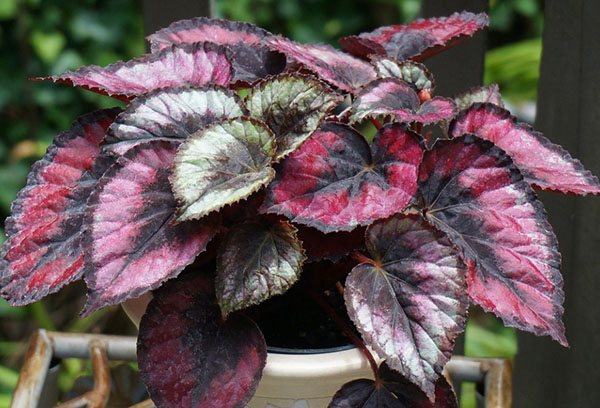

Propagation by stem cuttings
With a sharp knife, shoots are cut from the end of the stem 8-12 cm long. The lower leaves are removed, the remaining ones are cut in half. Then the cuttings are dried for 1-2 hours.
After that, the sections are treated with a root formation stimulant, for example, Kornevin or Heteroauxin, and planted in the ground to a depth of 1-2 cm.
A mixture of sand and begonias in equal parts is used.
The container with sprouts is covered with glass or cellophane... Care after this is to regularly ventilate the "greenhouse" and, if necessary, moisten the soil from a spray bottle.
After the young leaves appear, the glass is removed.
Botanical description, history of origin, how does it bloom?
Perennial shrub with hanging shoots. Asymmetric leaves can reach 120 mm, have an elegant but slightly oblong shape, the surface is smooth. On the one hand, the plant is red, and on the other, greenish with dark shades at the edges of the leaves. Coral-red flowers with a diameter of 1.5 cm are located only in groups, usually collected in a racemose inflorescence.
The flowers of the plant are unisexual. Blooms in the summer. Around 1956 in London at an auction among orchids, a new type of flower appears - the Royal Begonia. A little later, breeders bred dozens of different varieties. Since then, the plant has evolved into many hybrid species. The plant was crossed with Asian species. Why the royal begonia remained the progenitor of all common varieties.
Care problems
- The leaves of royal begonia can become brown spots due to sunburn. The plant should be removed from the scorching sunlight;
- Leaf edges can dry out as a result of low ambient humidity;
- The leaves lose their brightness and become thinner when there is a lack of lighting. It is enough to put the flower pot in the light (scattered) - and the problem will be solved;
- Leaves begin to turn yellow as a result of a lack of nutrients or insufficient watering. Regular feeding and regular watering will be the solution to the problem.
Royal begonia will be a chic decoration of any interior... A little effort and time - and she will thank you with the splendor of bright foliage!
Cultivation errors and pathogens
The Royal Rex is most susceptible to rot and mildew. Overflow or residual moisture on the leaves leads to the formation of foci of fungal and bacterial lesions. It is very difficult to cure a diseased plant. You can try to save the flower by deliberately drying the surrounding air and treating it with fungicides. Severely affected stems and leaves will have to be cut off.
If the rot begins to rise from the root, you will have to destroy the begonia.
Too dry, hot, or cold air causes the leaves to lose color and dry out at the edges. After the microclimate is restored, the plant will regain its full strength and beauty.
If it is weakened, parasites can take a liking to it. Spider mites, scale insects, thrips and aphids are capable of leaving nothing of the flower in a matter of days.
To get rid of pests, you need to mechanically remove their clusters, thoroughly wash the leaves and stems with soapy water and then repeatedly treat with a specialized insecticide.
How to prune
As such, royal begonia does not need pruning. Pinching is used to form a fluffy crown. This procedure is carried out in early spring, when young shoots have already begun to grow near the flower. In order for the crown to be thick, and an ornamental bush to form, the tip of the shoot is pinched 1 cm from the top.
Pruning is carried out only in case of plant disease. Dry or damaged leaves are then removed. This is done with a sharp, sterile knife, the places of the cuts must be sprinkled with crushed coal in order to avoid infection of the plant with bacteriosis.
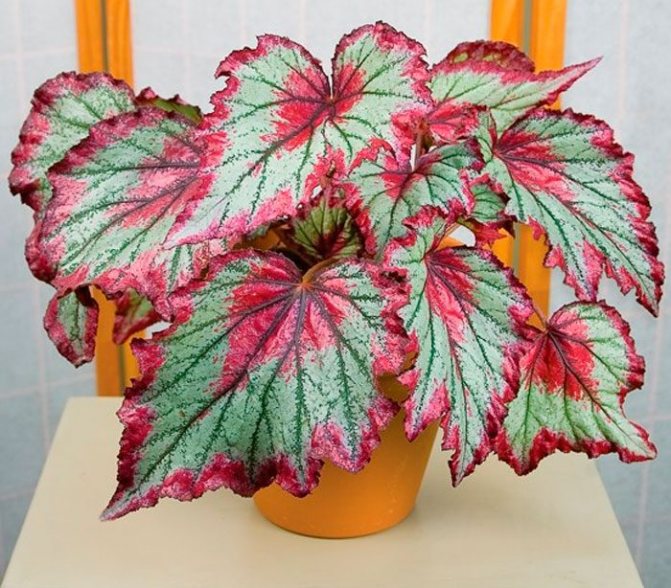

Begonia Rex considered one of the most beloved and beautiful flowers, which is also called royal begonia... It differs in that it has luxurious leaves of a wide variety of shapes and colors: round, elongated, oval, heart-shaped, smooth, maple-shaped, scaly.
Begonia royal more an ornamental plant than a flower, since there are simply none on it. The variety of leaf shapes, as well as their beauty, more than make up for the lack of flowering.
She also enjoys such great recognition among flower growers because begonia is an unpretentious plant with fairly simple care.
Rhizome division
This method is used for adults, strong specimens that have reached 4-5 years of age. For this, the begonia is removed from the pot, the root system is washed with water.
With a sharp knife, the rhizome is divided into parts so that each of them has at least one bud.
When begonias propagate, the places of the cuts are sprinkled with crushed charcoal.
The roots are processed with Heteroauxin or Kornevin. Each of the parts is planted in an individual pot and watered.
Care
Temperature regime
Since this plant is native to the tropics and subtropics, it loves indoor warmth (but not heat!). The optimal summer temperature will be between 16 and 22 degrees above zero. In the warm season, the pot can be put out on the street or on the veranda, but beware of the flower from drafts.
In winter, the air temperature is reduced to 16 degrees Celsius.... During this period, the most important thing is that the roots do not overcooled, because they will no longer supply nutrients to the ground part of the flower. And the leaves should not be overheated, since because of this they can dry out and the plant will lose its attractive appearance, which will not be able to recover for a long time. All important tips for caring for Royal Begonia can be found in this article.
Watering
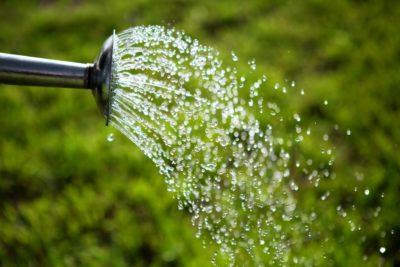

Watering Begonia must be abundant, especially during the hot period. The signal for the next soil moisture will be the dry topsoil. The “queen” prefers humid air around her, but it is not necessary to spray her, because spots may appear on the leaves. The best way out of this situation is to spray the air or place a container of water next to the flowerpot.
This type of Begonia has very large leaves that collect a lot of dust on their surface. therefore it will not be superfluous to wipe the flower with a dampened cloth at least every half month.
Important! Do not dry the soil to such an extent that it begins to lag behind the side surfaces of the flowerpot. If this happens, do not fill the flower, but immerse the pot in a container of water and let the Begonia nourish it for about 30-40 minutes.
Remember that all queens are very fragile creatures. Begonia is no exception. Therefore, when caring at home, be very careful when handling a houseplant.
Top dressing
Please note that you should not expect a full return from the plant if you do not resort to complex fertilizers. This is especially necessary in the spring, during the period of awakening and active growth of the royal flower.The composition of the dressing should include nitrogen and potassium.
And to stimulate root growth, phosphorus is also added to the listed elements. Water the soil well before fertilizing, because feeding can harm dry roots.
In addition to mineral elements, gardeners are advised to use organic ones. It can be horse or cow manure diluted with water (200 g of manure is added to 1 liter of water).
Pruning
This procedure is essential when growing plants. It is necessary to improve flowering, maintain the ratio between the underground and above-ground parts of the flower. preservation of the aesthetic appearance. Begonias grow relatively quickly, but the foliage becomes smaller in size, and flowering ends altogether.
The first pruning should be done when the flower height reaches 10-12 cm... You have the opportunity to choose and shape the desired plant shape. After this procedure, watering is reduced until the beginning of active growth. Remember to get rid of crooked and dried out branches.
If you still did not circumcise the "princess" in time, and she lost her aesthetic appearance, we recommend re-rooting her. Use knives or scissors with well-sharpened blades to avoid injuring the shoots. Sprinkle the cut areas with wood ash to speed up healing.
Mr. Dachnik recommends: begonia rex - doctor for asthmatics
Thanks to its large, fleshy leaves, rex perfectly purifies the air. It releases a lot of oxygen and active phytoncides. It was possible to find out that in the room where some varieties grow, the concentration of Staphylococcus aureus decreases.
It is useful for people with bronchial asthma to have such a flower at home. It has antimicrobial properties, reduces the risk of allergies, and improves immunity.
The humidified air, so essential for plant health, prevents flying dust particles from entering the air and makes breathing easier.
By the sign, begonia helps people of creative professions and contributes to a favorable atmosphere at home.
Reproduction methods
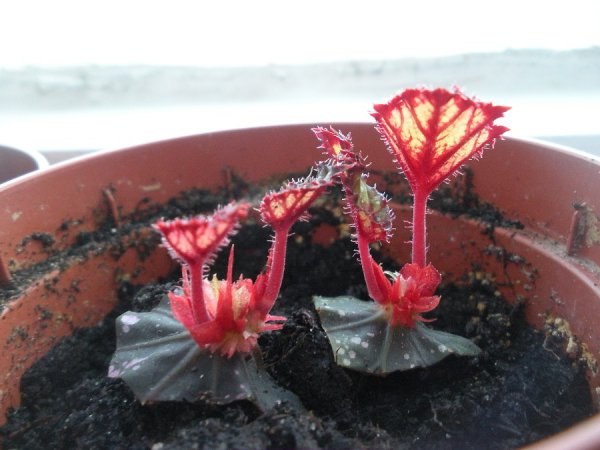

To get a new ornamental shrub, it is not necessary to purchase a pot with a tropical guest. An undemanding beauty at home is easily bred with three proven methods. Each of the methods has its own subtleties, which must be understood.
Seeds
Breeders prefer royal begonia flower propagation using sophisticated technology. Small planting material has a low germination rate, is capricious when germinating. In the spring, seeds are sown in a container with loose soil, sprayed with a spray bottle, covered with glass, left in the sun at a temperature of + 23-27 ° C. Pecking occurs after 2-3 weeks, and with the appearance of two adult leaves, they are transferred to separate pots.
To prevent the seedlings from rotting from fungi, it is necessary to regularly ventilate the greenhouse, water it with a fungicide solution. In good light, the bushes develop quickly, do not stretch. If the weather is cloudy, then professionals use a phytolamp. Twice a month they are fed with fertilizers and hidden from cold drafts.
By dividing the roots
Reproduction of the royal begonia flower takes place with regular transplantation. Carefully remove the adult specimen from the pot, being careful not to damage the system. Remove excess soil, stratify the roots into small pieces. The shoots must have buds, twigs.
Places of cuts are powdered with Kornevin powder, the plant is transplanted into separate containers. The bushes are watered abundantly, placed on a warm light windowsill. Evening spraying with an aqueous solution of the Epin preparation will help reduce stress and improve survival rate.
Cuttings
For beginners, the less troublesome method is suitable. Reproduction of the royal begonia flower by leaves, shoots allows you to maintain varietal characteristics in a short time. The plates are cut along the veins into small triangles, and 2-3 buds are left on the branches.The planting material is pressed against wet soil, covered with a film on top.
Every day the beds are aired, the blanks are sprayed with warm water. After a few days, the germinated fragments of greenery, the seedlings are transferred to separate pots. To improve the survival rate, they are soaked in Zircon solution before the procedure.
1. Seven Secrets of Success:
| 1. Growing temperature: grown at normal room temperature ranging from 18 to 24 ° C throughout the year. |
| 2. Lighting: well-lit place without direct sunlight, it is possible to grow under artificial supplementary lighting. |
| 3. Watering and humidity: with water at room temperature, dry the topsoil between waterings, the air humidity is quite high. |
| 4. Pruning: Remove old dried leaves in a timely manner to maintain an attractive appearance. |
| 5. Priming: loose, well-drained soil with sufficient nutrient content and acidic pH. |
| 6. Top dressing: in the warm season, we feed 2 times a month. |
| 7. Reproduction: leafy and stem cuttings in spring and summer, division of large plants during transplantation, seeds and daughter rosettes. |
Botanical name: Begonia imperialis.
Family... Begonias.
Homeland of the plant... Southeast Asia and India.
Description. Indoor royal begonia or rex begonia is grown for spectacular, colorful foliage in a wide range of shades, shapes and textures. The leaves are large with streaks or specks of silver, pink, purple, green or burgundy. Tiny, nondescript flowers appear on tall stems, it is advisable to remove them so that the plant does not waste energy on flowering to the detriment of the leaves. It is a rhizome begonia with a thick, fleshy root located just below the soil surface. The size of the leaf plate is variable, but mainly 22 cm long and 12.5 cm wide, while the plant itself reaches a height of only 30 - 40 cm. Some types of royal begonias fall into a dormant period in winter.
Height... Reaches a height of 30 cm.
The benefits of the plant
Not many people know that breeding begonias is not only interesting, but also a rather useful hobby that can bring considerable benefit to a person.
The plant has the following qualities that are beneficial for the grower:
- unpretentious to living conditions;
- does not require painstaking care;
- helps to cleanse the air from small pollutants;
- has antimicrobial properties.
Did you know? Plant phytoncides were officially discovered by the famous Soviet biologist Boris Tokin in 1928. Although even in the second half of the 18th century, Ilya Mechnikov argued about the existence of this kind of substances.
In addition, the flower is capable of producing specific substances into the air, the so-called phytoncides, which contribute to:
- strengthening immunity;
- increasing resistance to stress;
- improving performance and endurance;
- great mood.
Pests and methods of dealing with them
Begonia can be affected by scale insects, thrips, and spider mites.
For prevention, you need to carry out regular inspections of the leaves for the presence of pests.
In advanced cases, treatment with special medications will be required.
Royal begonia will perfectly fit into any interior. Thanks to the colorful coloring of the leaves, it will become a rich living decoration in the house.
The rich variety of begonias makes you think about which variety to choose. On our site there is a lot of information about decorative leafy begonias and their care, as well as about the Red-leaved, Barshevikolisnaya, Spotted, Collar and Bauer and Mason begonias and about the Cleopatra variety.

